About the Bird Photographer of the Year competition
This year's competition saw more than 22,000 images entered by photographers around the world, all vying for the £5,000 grand prize. The awarded images appear on the Bird Photographer of the Year website and in a hardback book, published by Harper Collins and with a foreword by actor, musician and comedian Bill Bailey.
The overall Bird Photographer of the Year was awarded to Alejandro Prieto for his image of a greater roadrunner at the USA-Mexico border wall.
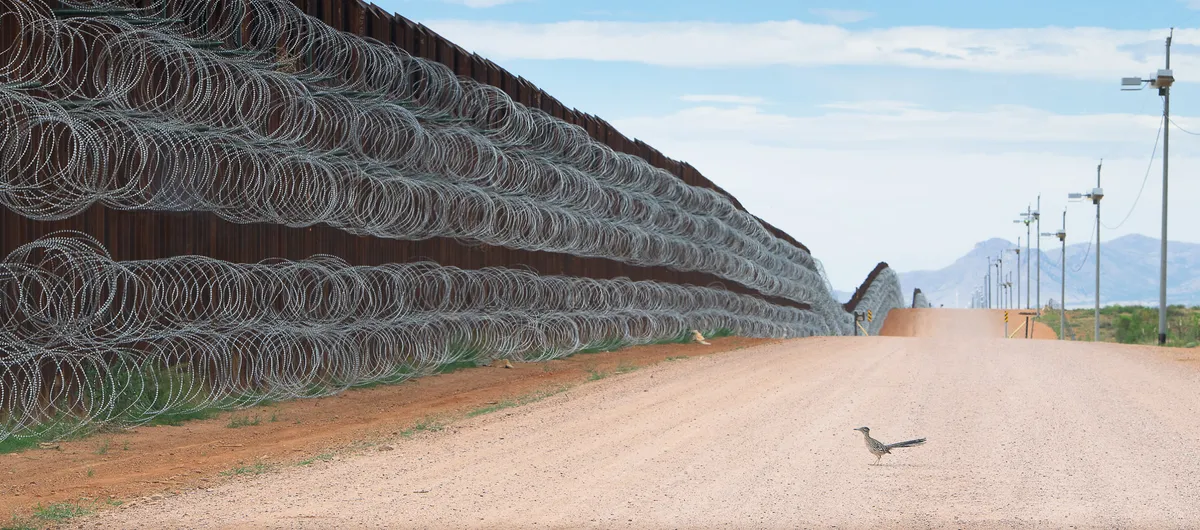
“Prieto’s image immediately caught the attention of the judges. It is not your typical bird photo, and the story behind the image is so strong,” says David Lindo, birder and competition judge. “The roadrunner appears so vulnerable facing up to the huge border wall that dominates the frame.”
Alejandro's winning image featured in the February 2021 issue of BBC Wildlife Magazine as part of a photo story of his project to document the impact of the border wall on wildlife. The photo story can now be found on the website as gallery.
The competition covered eight main categories in the adult competition, plus a Conservation Award and a Portfolio Award. There was also a Young Bird Photographer of the Year section to the competition, split into three age groups.
The overall Young Bird Photographer of the Year was awarded to 17-year-old photographer Levi Fitze for his image of a male black grouse lekking at sunrise.
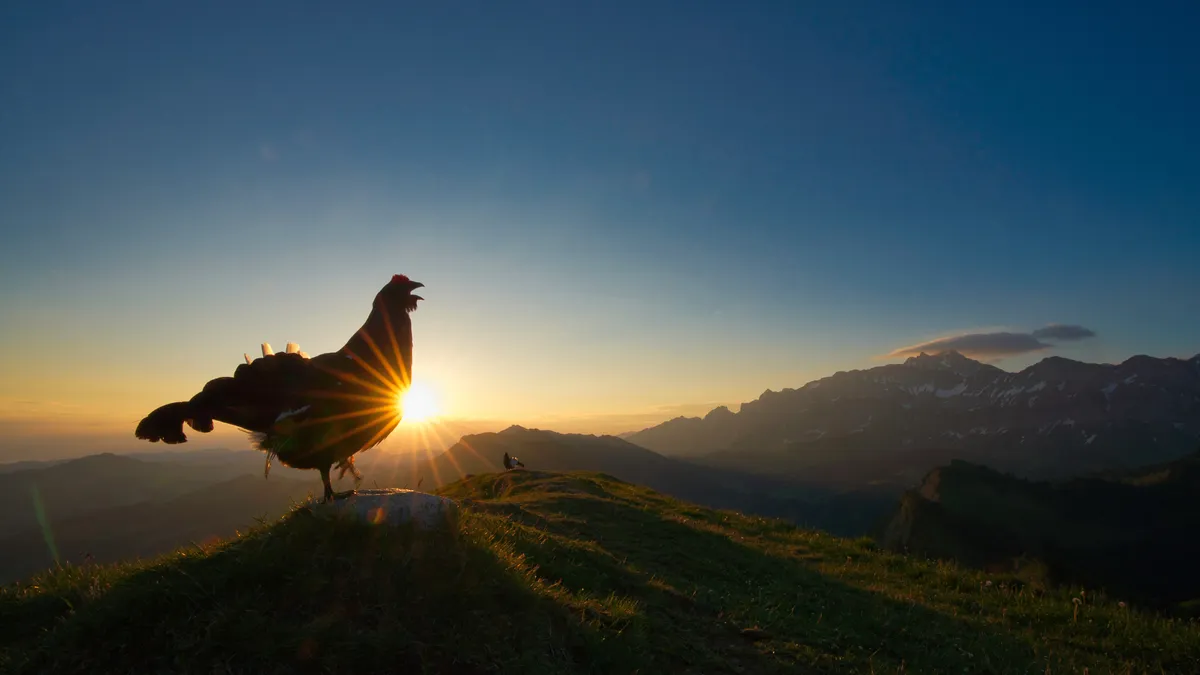
This year, the Bird Photographer of the Year donated more then £8,000 to its partner charity Birds on the Brink, which supports grass-roots bird conservation projects around the world.
The 2022 competition will open on 30 September 2021.
To view the images as a slideshow, click on the arrows in the top right hand corner of the photos below.
Category: Birds in the Environment
Gold Award winner, and overall Bird Photographer of the Year. BLOCKED: Great roadrunner, by Alejandro Prieto (Mexico).

"The 3,000km-long US–Mexico border traverses and straddles some of the continent’s most biologically diverse regions. It is home to uniquely adapted mammals, reptiles, birds and plants, some of which are found nowhere else on the planet. Numerous species will be affected if the US government decides to build a wall along the border with Mexico.
Border infrastructure not only physically blocks the movement of wildlife but it also destroys and fragments habitats. Many desert animals are, to a degree, nomadic wanderers and a wall would sever habitat connectivity and prevent them moving freely from one place to another. In this photograph, a greater roadrunner approaches the border wall at Naco, Arizona, with what almost looks like a sense of bewilderment."
Nikon D850 with Nikkor 70–200mm f/2.8 lens. Focal length 112mm, 1/320 second, f/14, ISO 200.
View more of Alejandro's images from his project documenting the impact of the border wall on wildlife in our online gallery.
Silver Award winner. CLAIMING THE FOREST FLOOR: Ovenbird, by Joshua Galicki (USA).
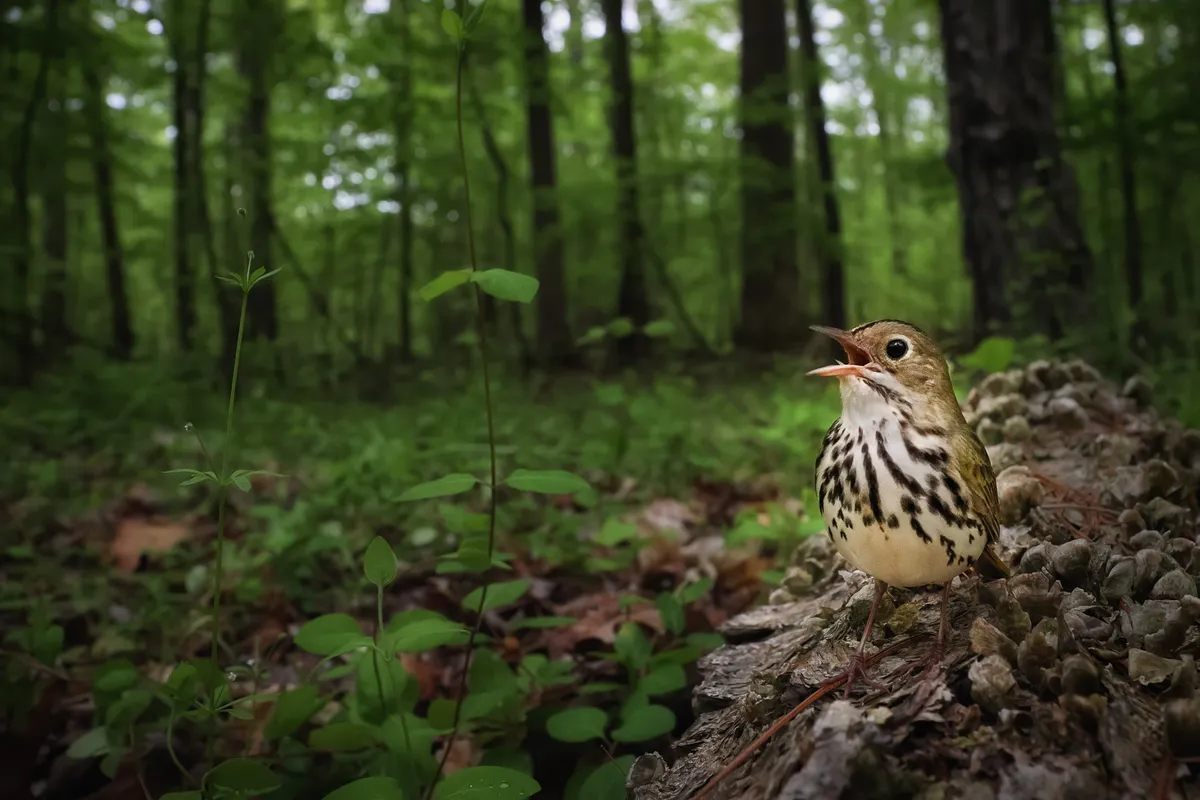
"This image shows a male ovenbird singing on top of a fallen log. The bird is staking its claim to a breeding territory shortly after arriving from a lengthy migration to the northeast United States from wintering grounds in Central America. Ovenbirds are quite small – 15cm or so in length – and unlike most other New World warblers, prefer to forage on the forest floor among the leaf litter. I have observed and studied North American songbirds for years and care deeply for all of my subjects.
This shot was taken with a non-intrusive remote set-up to capture the expanse of the ovenbird’s environment. The camera and lens were camouflaged next to the bird’s favourite singing log and the shutter was remotely triggered. No bait or tape lure were used for this shot, nor was any stress placed on the bird. As a result, this is an image of an ovenbird behaving naturally."
Canon EOS-1D X Mark III with Canon 24–70mm f/4 lens. Focal length 24mm, 1/500 second, f/8, ISO 6,400.
Category: Best portrait
Gold Award winner. UNDERWATER PORTRAIT: Brown pelican, by Felipe Foncueva (Spain).
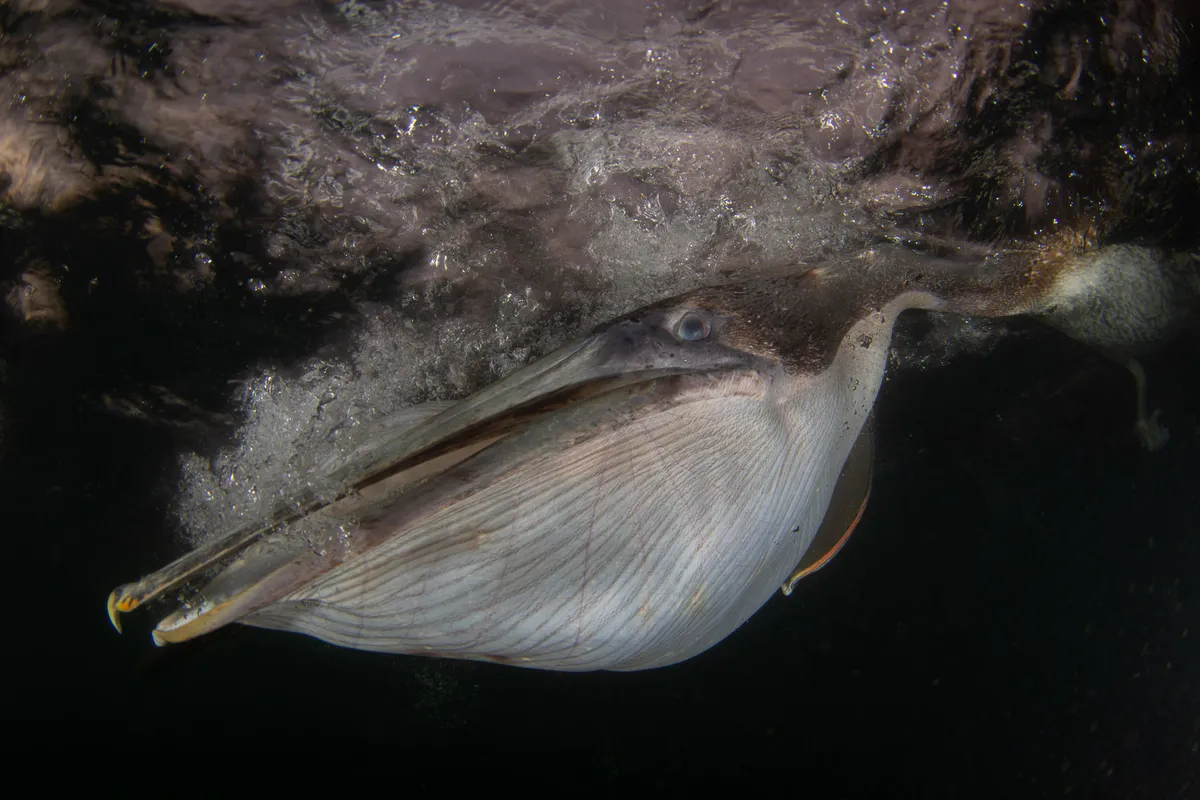
"This underwater image of a brown pelican was taken off the Pacific coast of Costa Rica, near the mouth of the Tárcoles River, where there are small fishing villages. Groups of pelicans await the return of fishermen and take advantage of the scraps they throw into the sea.
Looking at this image, I am struck by the similarity between the way the pouch beneath the pelican’s bill functions and the throat of a feeding baleen whale. At first glance you could be forgiven for thinking you are looking at a marine mammal rather than a bird!"
Canon EOS 5D Mark IV with Canon 8–15mm f/4 Focal length 15mm; 1/10th, f/9, ISO 200.
Silver Award winner. SING HEARTILY: Demoiselle cranes, by Maofeng Shang (China).
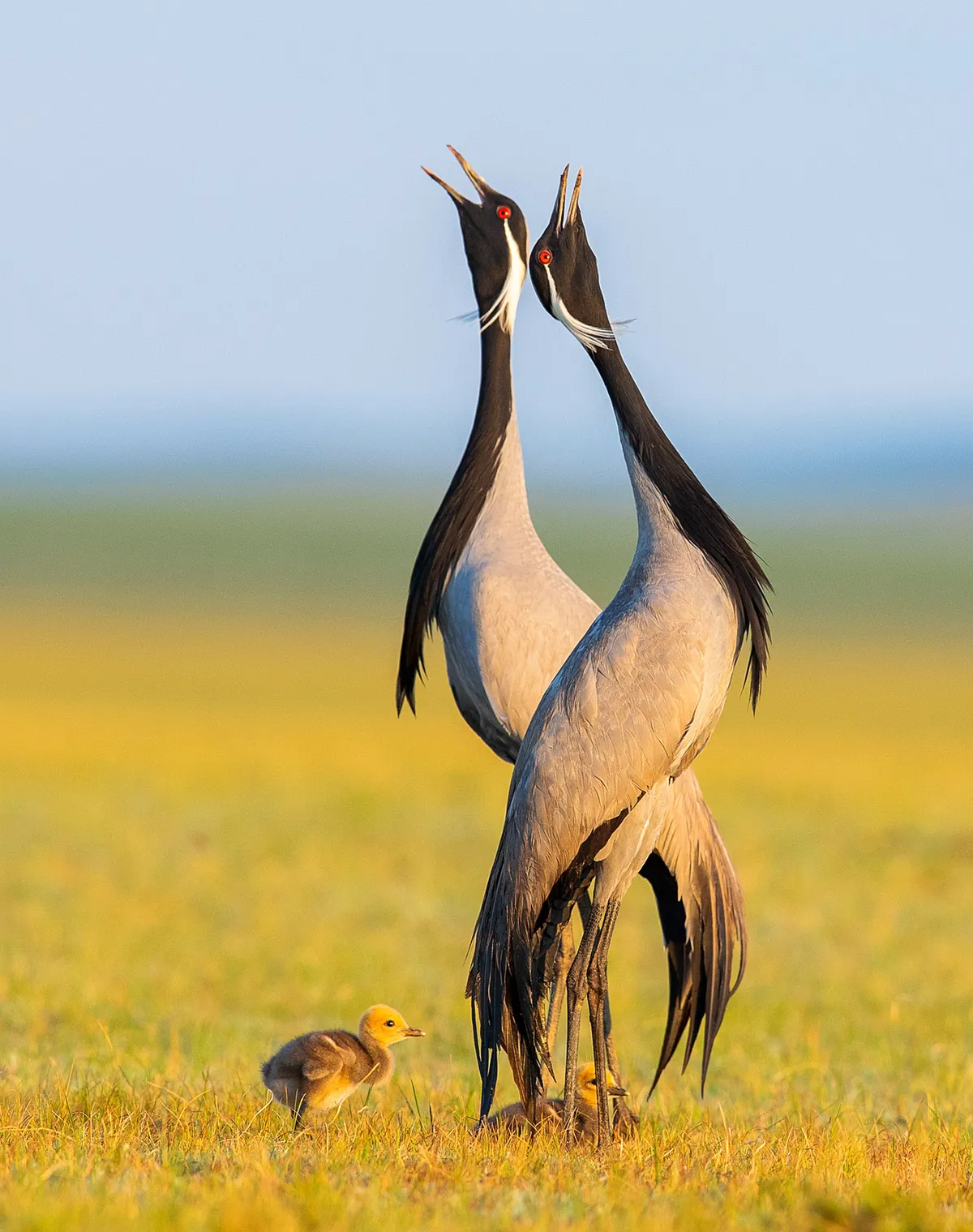
"June marks the start of the breeding season for demoiselle cranes on the vast grasslands of Keshiketeng in Inner Mongolia. It is a blessing to witness the arrival of these beautiful birds, and a privilege to have documented their nesting behaviour. In order to capture wonderful, intimate moments of breeding behaviour without causing disturbance, I did a lot of homework. I drove more than 800km to the vast prairie of Keshiketeng two days before I planned to photograph and did my groundwork. I got up at 3am on 29 June 2018 and rushed to the location of the breeding cranes.
In order not to disturb their peaceful life, I had previously set up my equipment in the long grass and lay down, disguised on the ground. In the morning light, the figures of the demoiselle crane family of four gradually appeared out of the gloom. Just as they were leisurely foraging for food, suddenly the distant sound of shepherds herding sheep could be heard. It seemed as if the sound was enough to inspire the pair of adults to call, as they stood back to back. This evocative sound cut through the silent sky for a brief moment, then everything quietened down again. I enjoyed the company of the crane family for the next four hours."
Canon EOS-1D X Mark II with Canon 600mm f/4 lens, 1/640 second, f/6.3, ISO 400.
Category: Attention to detail
Gold Award winner. DISAPPEARING: King penguin, by Rafael Armada (Spain).
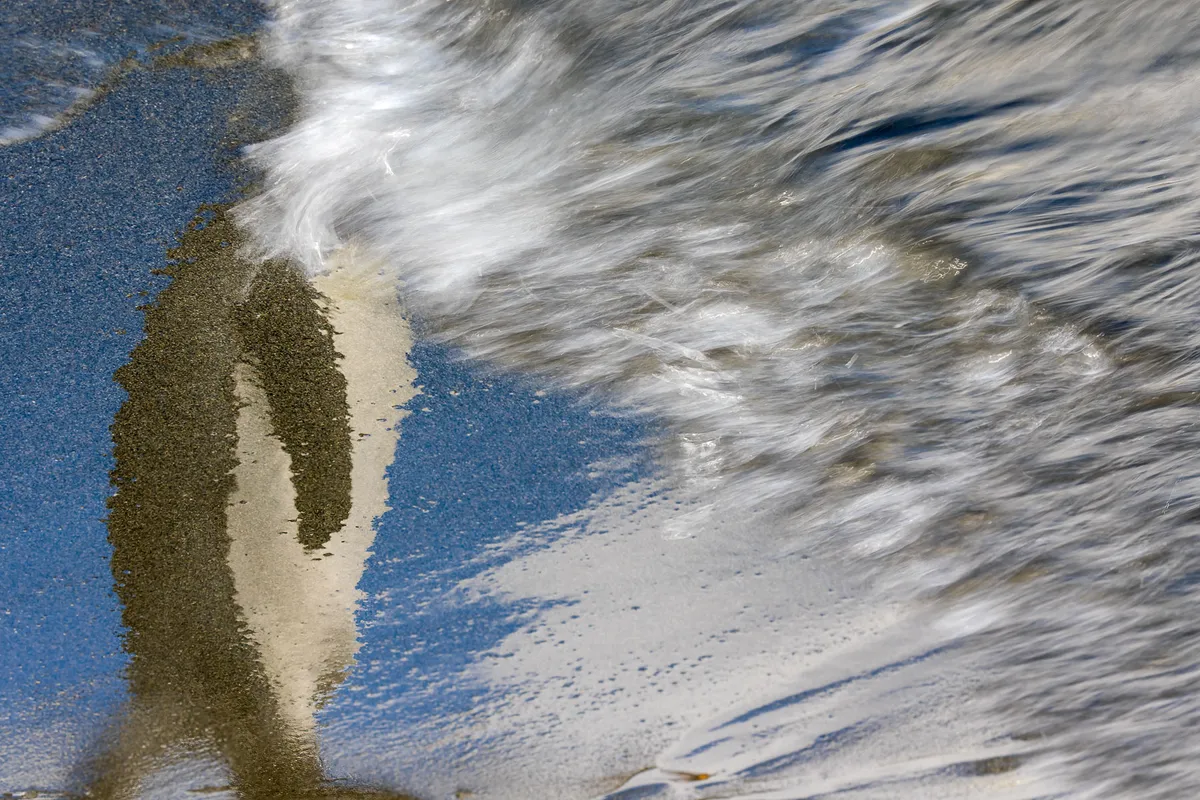
"Reflections are one of the details I like most in nature because light undergoes incredible transformations when it interacts with water. In a way, it is nature playing with us, with our forms and with the forms that we see. In this photograph, the same water that creates the reflection strikes with force to destroy it, in a sense to overthrow the King. The King is still standing; he knows his reign is not over… not yet. But it will end the day that water no longer creates reflections in the sand."
Canon EOS-1D X Mark II with Canon EF 100–400mm f/4.5–5.6 II lens. Focal length 100mm, 1/30 second, f/14, ISO 100.
Silver Award winner. GROWING UP: Great northern diver, by Raymond Hennessy (USA).
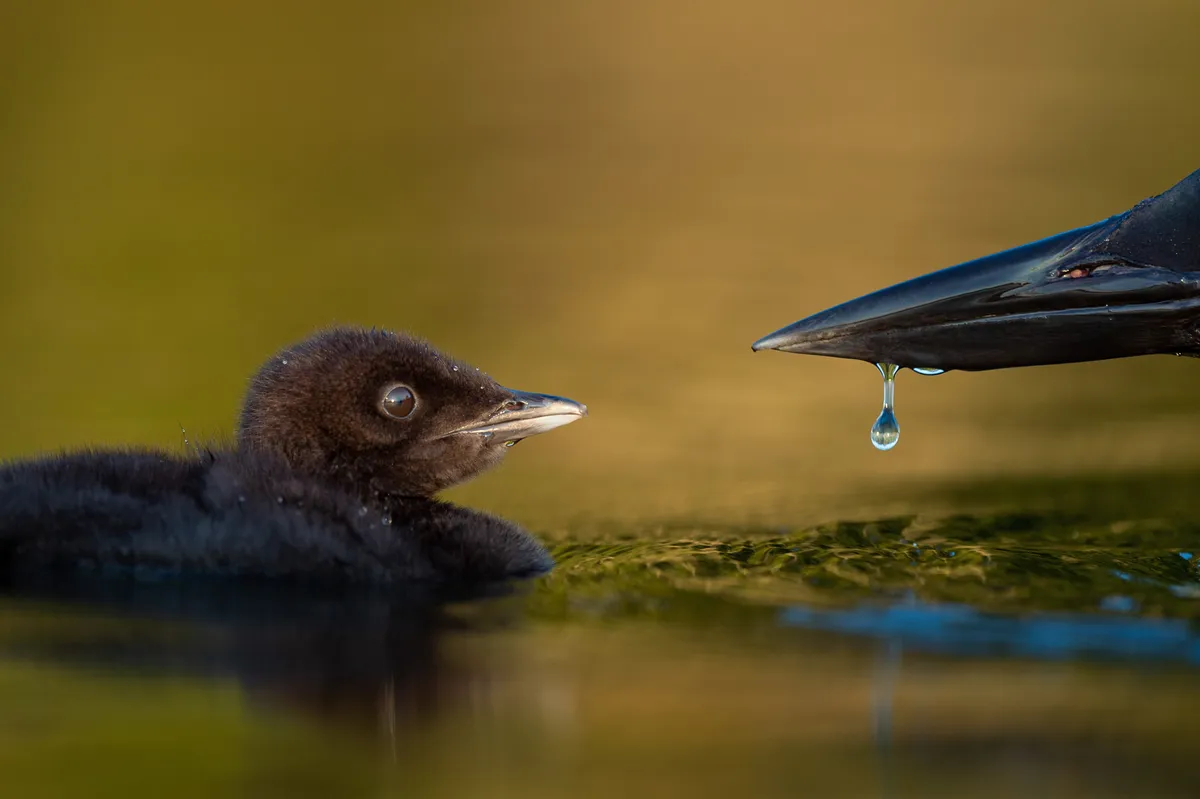
"Great northern divers (known as common loons in North America) and their chicks take to the water soon after the chicks hatch. The size difference between adult and youngster is evident in this image and shows just how much growing is left for this tiny chick: it is dwarfed by the large bill of the adult next to it. I took this photo as the pair floated incredibly close to my kayak in the soft afternoon light."
Nikon D4S with Nikkor 500mm f/4 lens. Focal length 500mm, 1/640 second, f/4, ISO 400.
Category: Bird behaviour
Gold Award winner. FLORAL BATHTUB: Crimson sunbird, by Mousam Ray (India).
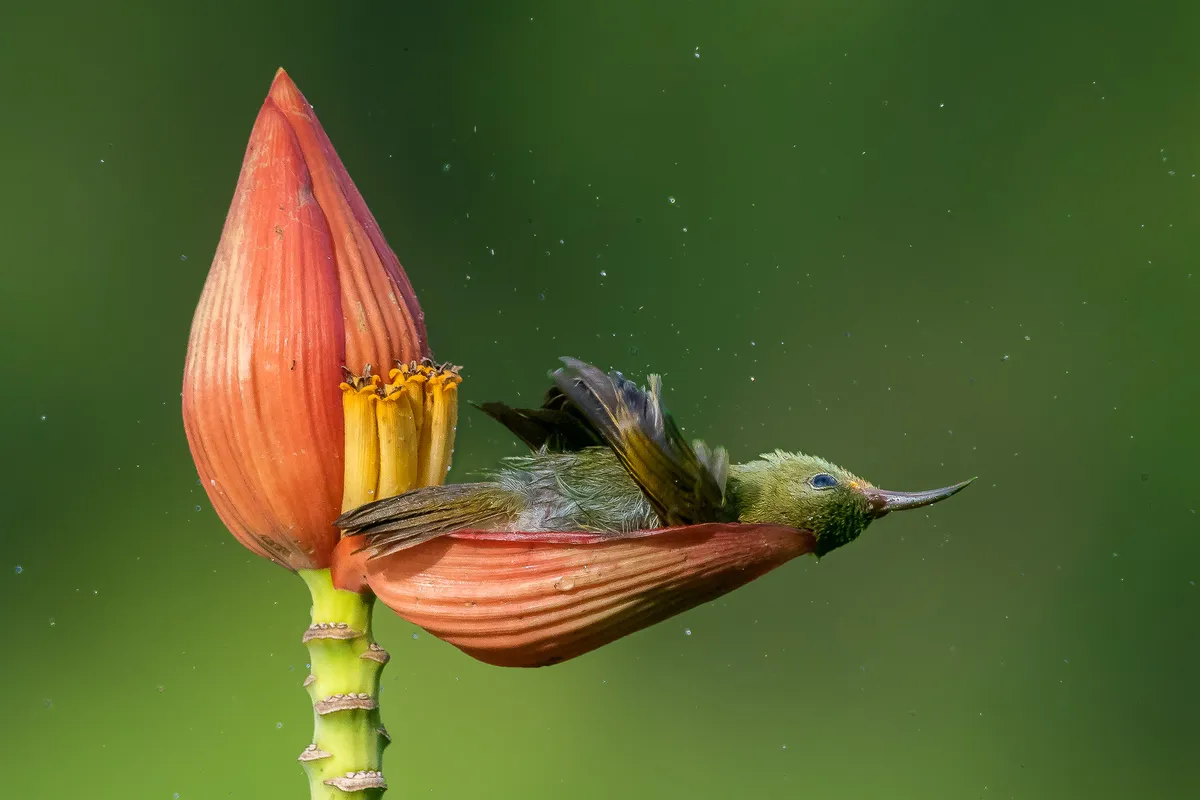
"This image was taken at North Bengal Agricultural University in Cooch Behar, West Bengal. To set the scene, here in India autumn days (when the photo was taken) are typically hot and humid – sporadic rains interspersed with sweltering heat – while the nights are cold. I was keen to capture images of crimson sunbirds drinking nectar from banana flowers. Typically, these flowers point towards the ground, but in some ornamental species they point skywards and some of their outer petals open up like cups, holding water from rain or dew.
Late one evening, a female crimson sunbird suddenly arrived and started sipping nectar. Her thirst quenched, she then started bathing in the water stored in this banana flower petal. It’s quite common to find birds refreshing themselves in the evening, visiting puddles and pools, dipping their heads and wetting their wings and body.
However, it was a unique experience to see this sunbird immersing herself upside down in water contained in an ornamental flower petal, like a lady in a bathtub. Her relaxed and indulgent manner, lit by the glow of sunset, was truly a sight to behold."
Nikon D500 with Nikkor 300mm f/4 and 1.4x teleconverter. Focal length 420mm, 1/4,000 second, f/7.1, ISO 1,600.
Silver Award winner. THE FACE OF DEATH: Purple heron, by Massimiliano Apollo (Italy).
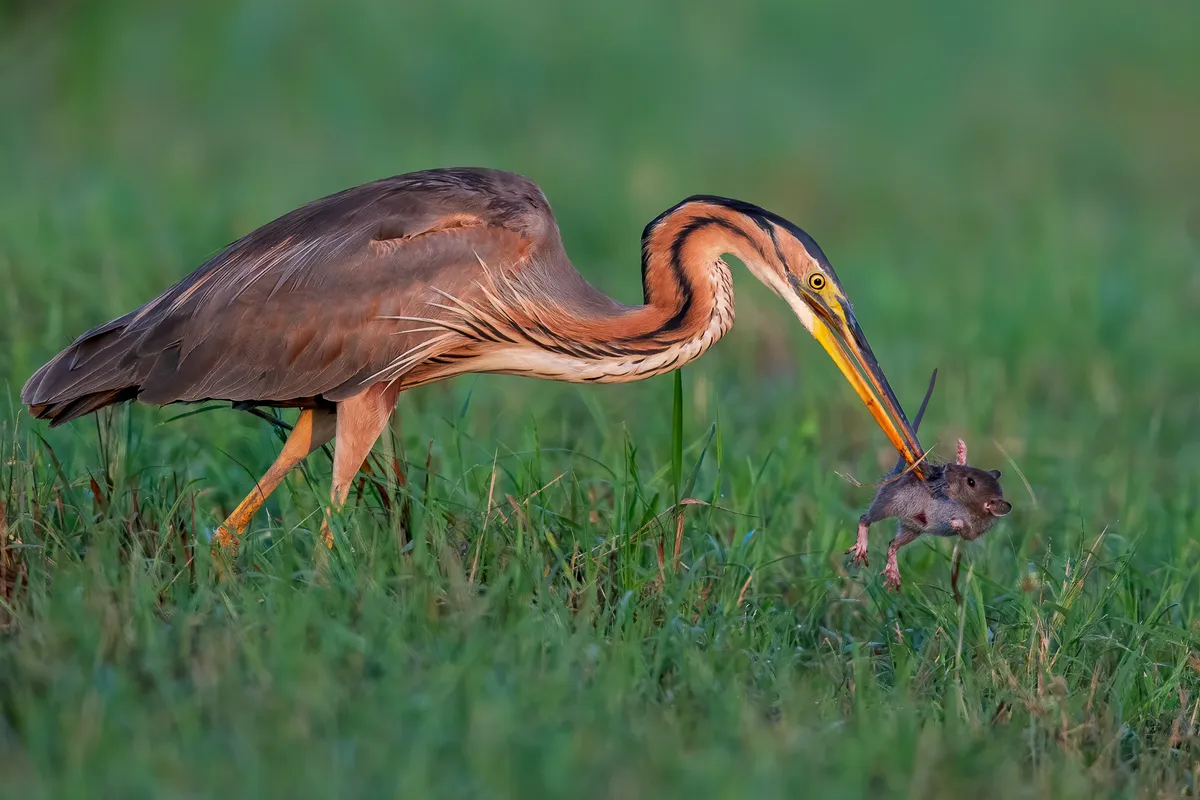
"After many years of frequenting these rice fields in northern Italy, I finally managed to capture what is for me the perfect shot! In late summer, prior to migrating south, the region’s purple herons try to feed as much as possible and take advantage of the abundance of prey present in the rice fields. I had long dreamt of a shot like this, one that would allow me to see the expressions of the two subjects – predator and prey. I can also say with some satisfaction that this shot is completely wild and no form of baiting was employed – just a lot of patience, perseverance and, why not, a little luck!"
Sony A9 II with Canon 600mm f/4 lens and 1.4x teleconverter. Focal length 840mm, 1/2,000 second, f/6.3, ISO 3,200.
Category: Birds in flight
Gold Award winner. THIRSTY: Common swift, by Tzahi Finkelstein (Israel).
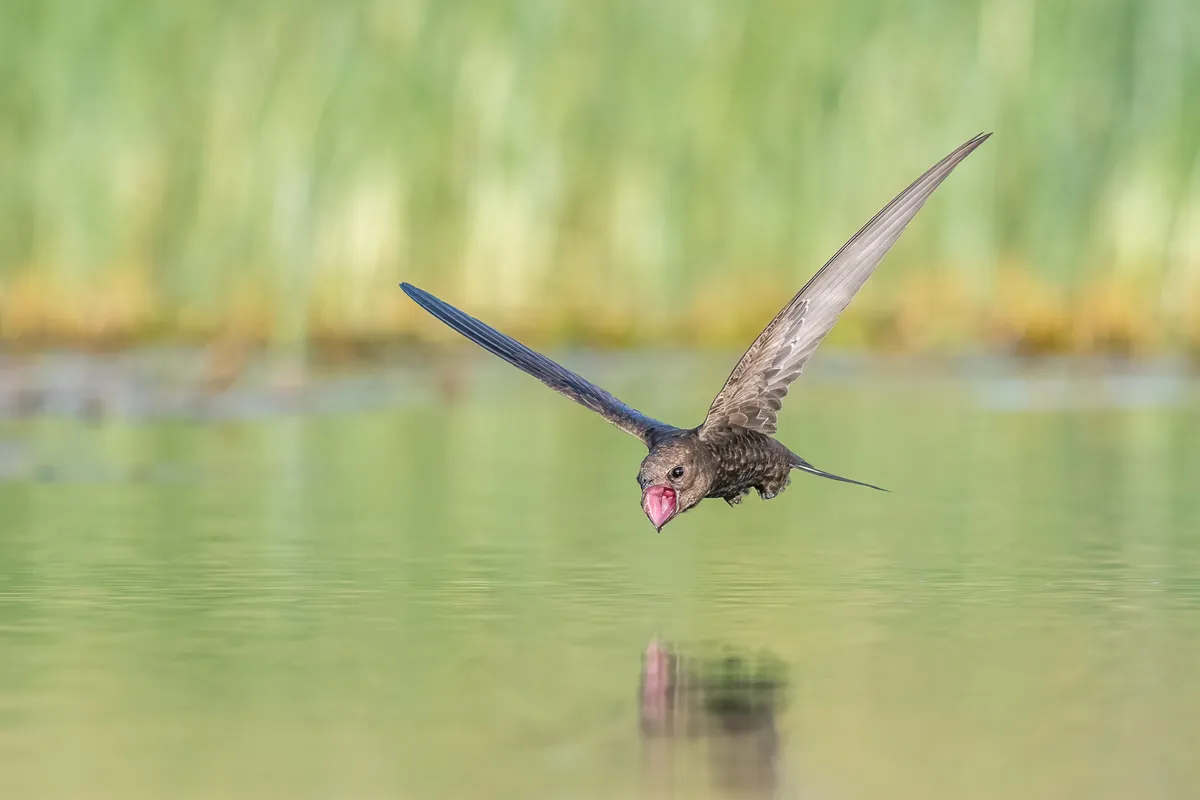
"Common swifts live their lives on the wing and are a challenge to capture in flight. With a diet of flying insects, they need to drink from time to time, and even that behaviour is performed on the wing. I had had this image – of a swift skimming over water – in my mind for a long time.
I finally found a suitable place to attempt it, and to get the photo I had to sit in water wearing a wetsuit, shrouded by a portable hide, every day for three weeks. Eventually, I got this photo on the final day – the day after the birds had all gone."
Nikon D500 with Nikkor 300mm f/4 PF lens. Focal length 300mm, 1/4,000 second, f/7.1, ISO 1,800.
Silver Award winner. THE ART OF MOTION: Hummingbird, by Nicolas Reusens (Spain).
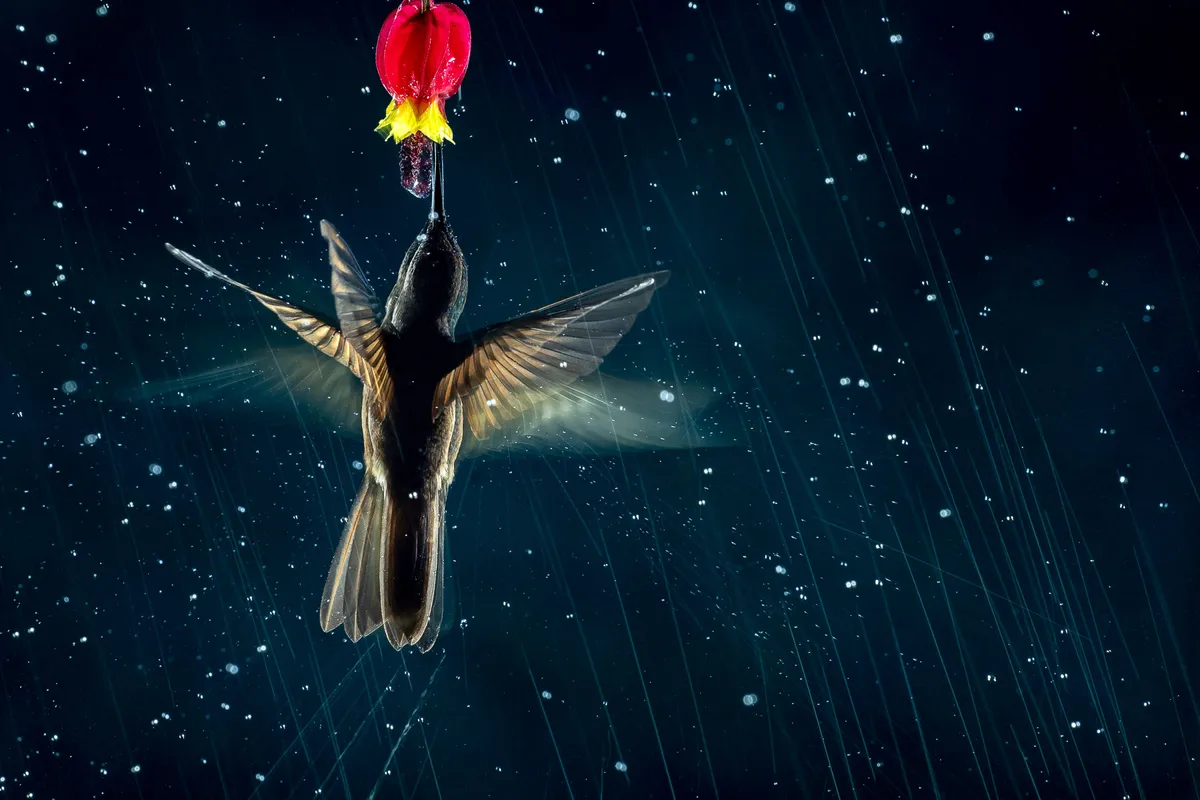
"This image is one of my favourite shots from my last trip to Ecuador. Using a complicated set-up, I was able to trigger two sets of flashes during a single exposure, using a shutter speed of 1/25 second. I then tried to introduce a sense of movement into the image by adding continuous lighting to the scene. After three days of photographic attempts to get a single picture with an intense atmosphere, this is what I achieved. I hope it was worth it!"
Canon R6 with Laowa 100mm f/2.8 Macro lens. Focal length 100mm, 1/25 second, f/13, ISO 200.
Category: Black and white
Gold Award winner. CHINSTRAP PENGUIN: by Renato Granieri (UK).
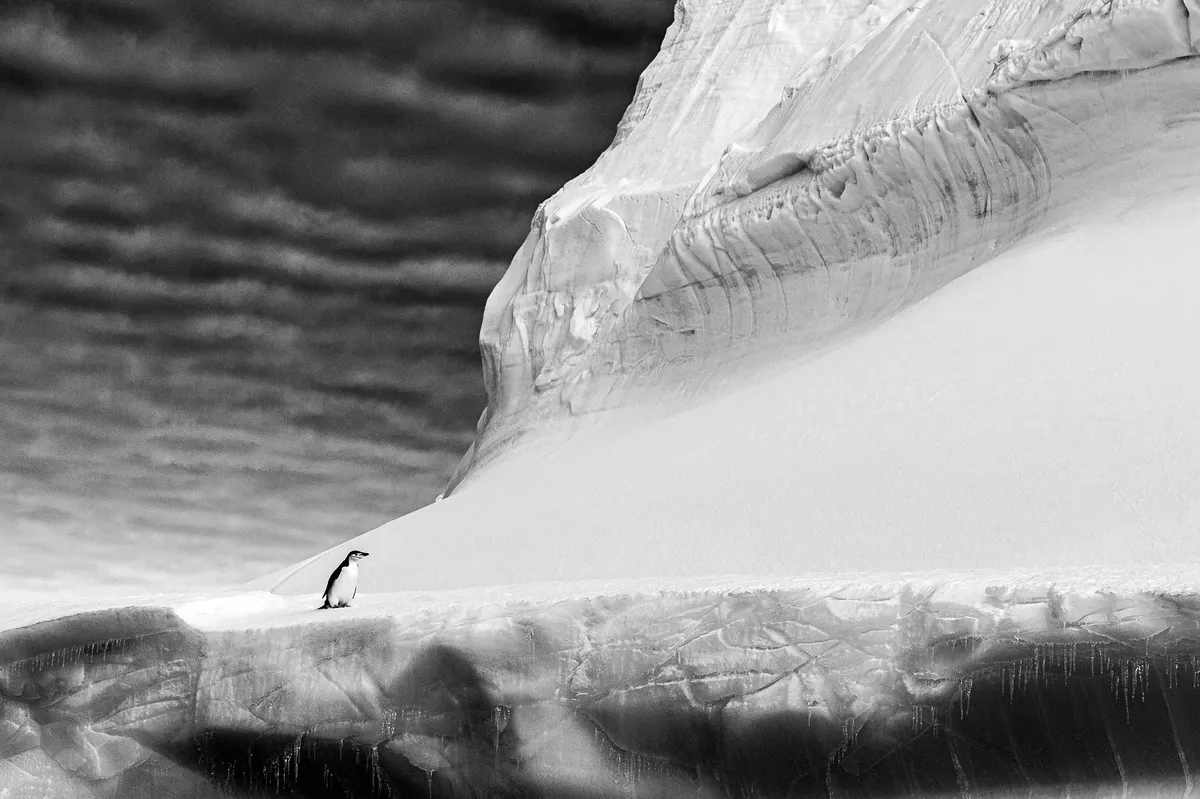
"I was lucky enough to spend some time on an expedition ship visiting Antarctica. During a Zodiac cruise I spotted a single chinstrap penguin on top of a giant iceberg. The relative sizes and proportions made me feel small in relation to the environment and I wanted to capture that impression photographically. Consequently, I included as much as I could of the iceberg in the photo to create a sense of scale."
Nikon D4S with Nikkor 80–400mm f/4.5–5.6 lens. Focal length 130mm, 1/1,250 second, f/16, ISO 800.
Silver Award winner. FEATHER LIGHT: Northern gannet, by James Rogerson (UK).
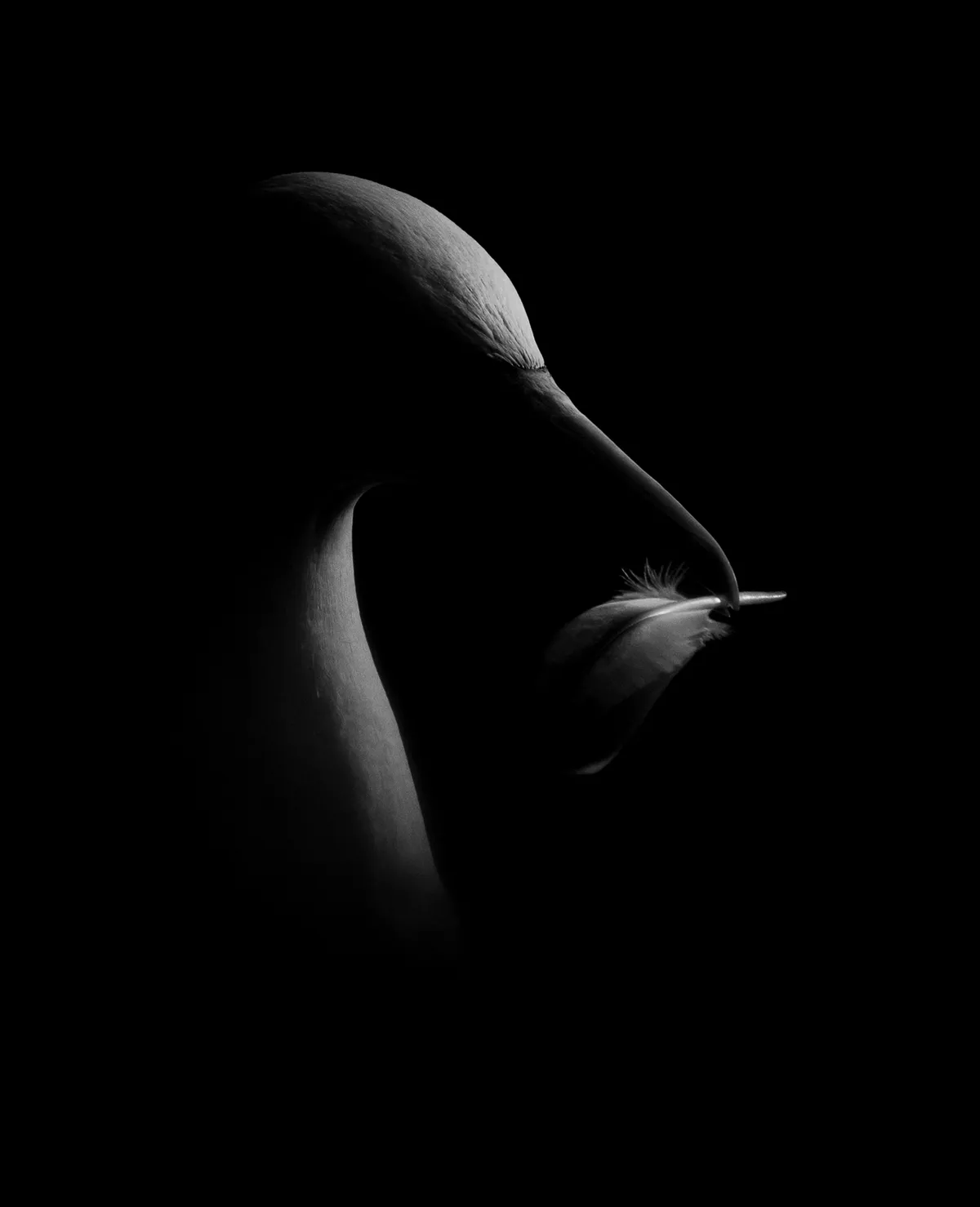
"Backlit by the rising sun, this preening Northern Gannet paused momentarily as it removed a displaced feather. The sequence of images I took that morning focused on metering for the highlights of my subject. I achieved this using the spot-metering mode, linked to the central autofocus point, and with that point trained on the brightest area of the bird. The result is that the merest suggestion of the bird’s outline becomes the focus, and yet the species is still instantly recognisable. Although it is several hours’ drive to the location from my home, I rarely shoot there for more than the hour or so when suitable light conditions prevail."
Canon EOS-1D X with Canon 500mm f/4 lens and 1.4x teleconverter. Focal length 700mm, 1/1,000 second, f/11, ISO 1,600.
Category: Urban birds
Gold Award winner. DIPPER ON A SHOPPING TROLLEY: White-throated dipper, by Terry Whittaker (UK).
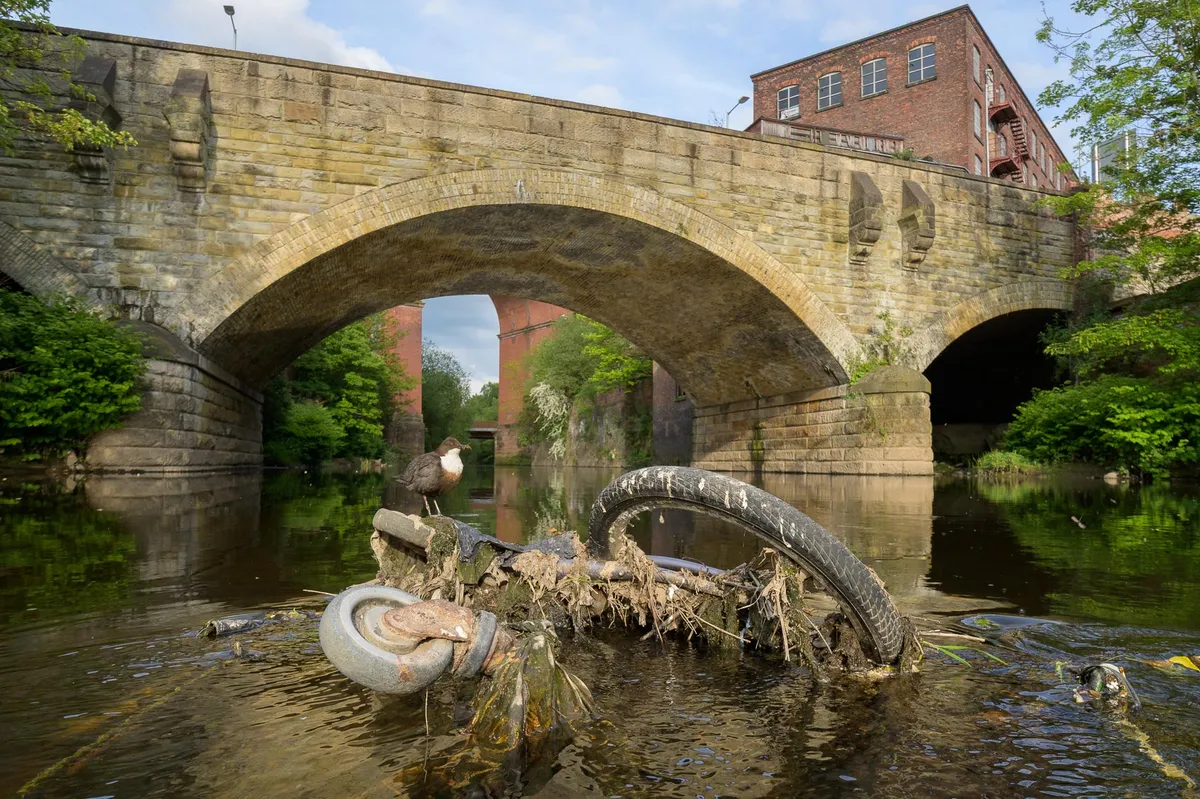
"A pair of white-throated dippers nest under an old road bridge on the edge of a town centre in Greater Manchester. To get an image that shows the urban environment in which they live, I put a remote camera and wide-angle lens in the river, which I triggered from the bank by radio. There is a shortage of natural perches for these semi-aquatic birds, so they use whatever is available – in this case a shopping trolley someone had thrown in the river."
Nikon Z6 with Nikkor 16–35mm f/4 lens. Focal length 22mm, 1/800 second, f/10, ISO 1,000.
Silver Award winner. LOCKDOWN: Karoo prinia, by William Steel (South Africa).
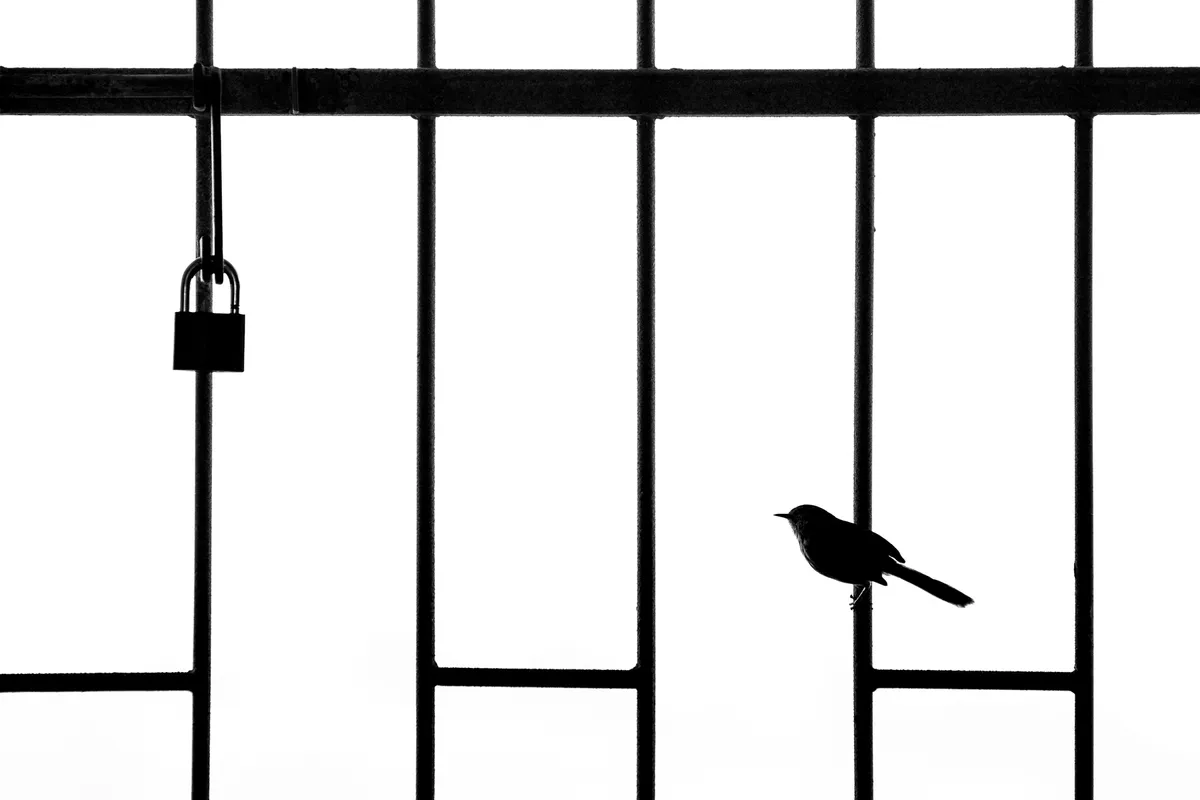
"For many people around the world, a large part of 2020 was spent at home. South Africa went into one of the world’s strictest lockdowns. This turned out to be the longest time I had spent at home in the last ten years. As a wildlife and travel photographer, I felt trapped. The only solution was to turn my camera towards the animals around me. The longer you spend observing the wildlife around you, the more you realise how many stories there are to tell.
Every morning this Karoo prinia would search for insects in the security gate at my front door. The insects drawn in by the outside light proved an easy meal for this clever bird. Adaptation is the key to survival in an urban environment, for humans and wildlife alike. I feel that the image is a striking symbol encapsulating the challenges we have faced with COVID-19 – a juxtaposition of fear and freedom."
Canon EOS 6D with Sigma 120–300mm f/2.8 Sport lens. Focal length 252mm, 1/3,200 second, f/4, ISO 800.
Category: Creative imagery
Gold Award winner. SPRATS AND BREAD: Common kingfisher, by Ruediger Schulz (Germany).
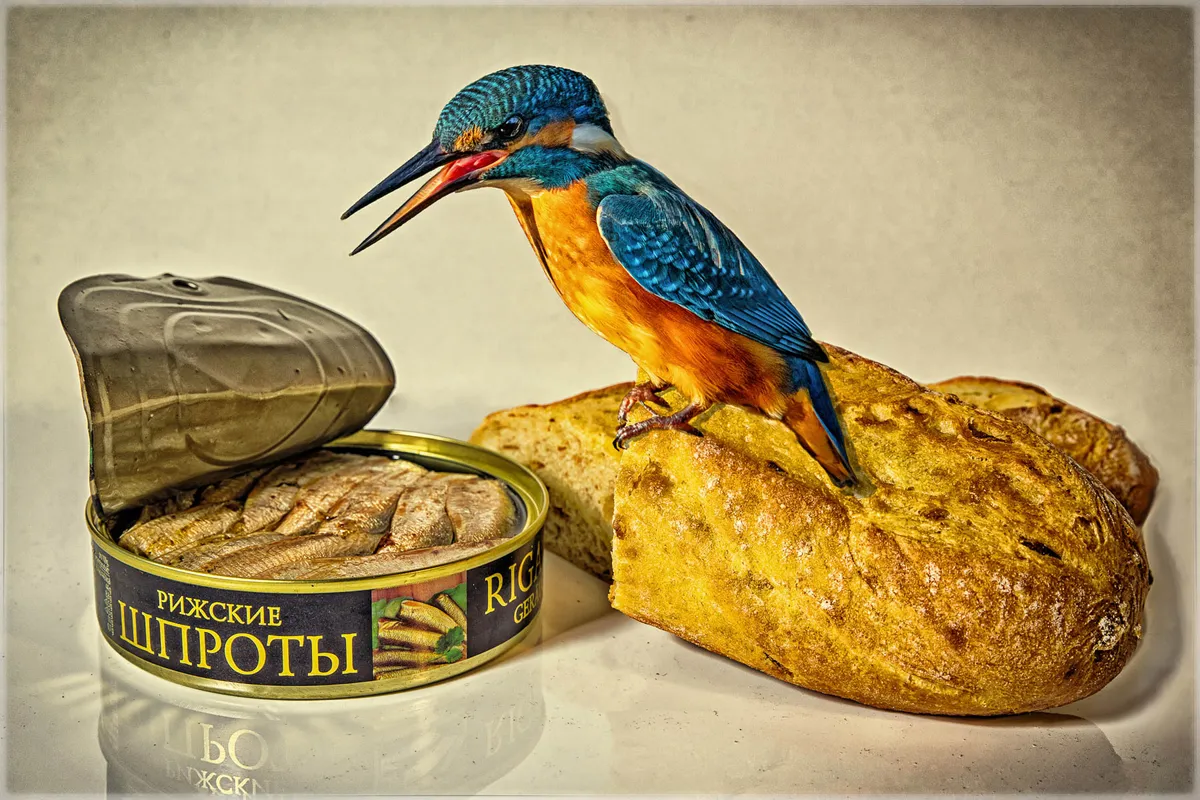
"The concept for this picture came to me spontaneously when I was editing photographs of a common kingfisher. To create the image, I cut out a close-up of a kingfisher and then looked for a photogenic tin of fish (which was trickier than expected) and used the bread as a perch for the bird. I arranged both on a white acrylic sheet and directed the light to match the shadow of the bird’s beak. Having composed the photograph, I edited the image with Nik Color Efex Pro4 to give it an antique touch."
Canon EOS 5D Mark IV with Sigma 150–600mm f/5–6.3 Sports lens and 1.4x teleconverter. Composite.
Silver Award winner. FUNNEL: Common starlings, by Kathryn Cooper (UK).
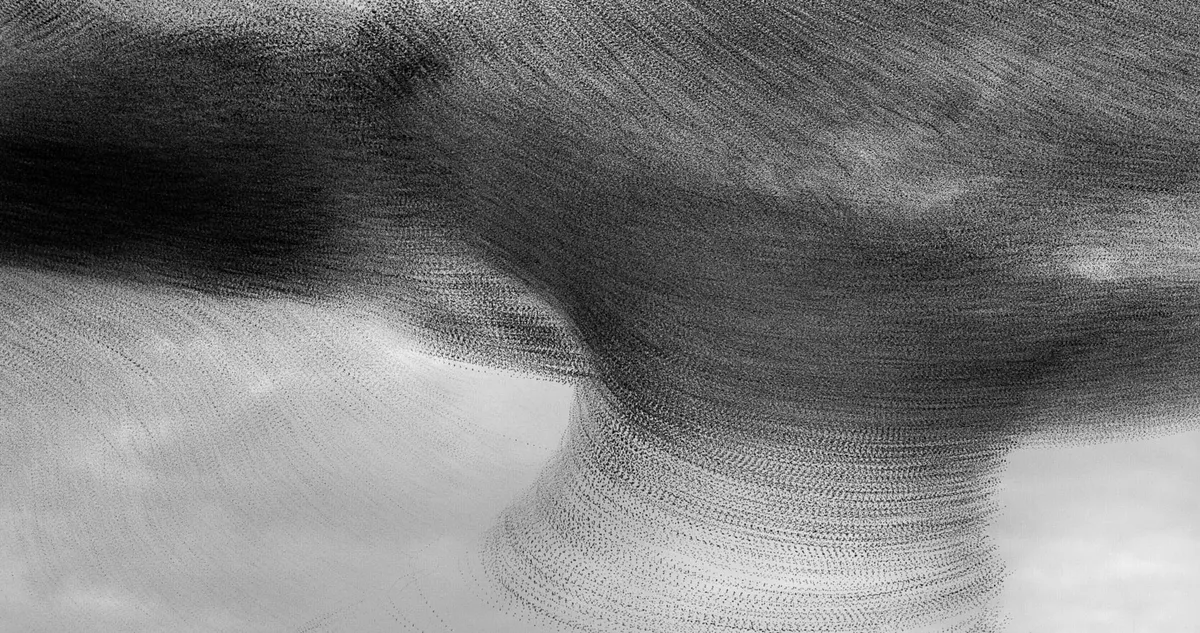
"Between November and March, tens of thousands of common starlings migrate to Yorkshire Wildlife Trust’s Potteric Carr Nature Reserve. My aim was to depict the fluid-like movement of a murmuration and capture its essence. I am interested in transient moments when chaos briefly changes to order – moments when thousands of individual bodies appear to move as one. Here, I’ve captured the flock’s swirls, twists and turns, forming shapes like funnels and tornadoes as the birds seek a suitable spot in which to land. Rather than using a typical long exposure, I adopted a technique whereby I merged aspects of consecutive images using my own coding."
Canon EOS 5D Mark IV with Canon 24–105mm f/4 lens. Stacked and merged exposures.
Category: Portfolio Award
Gold Award winner. LIFE ON THE EDGE: MY SUMMER WITH PUFFINS: Kevin Morgans (UK).
"A theme throughout this portfolio and the rest of my photography is back-lighting. This is a tricky style to master but, if done correctly, it can create a dramatic feel to your imagery and a final result packed full of atmosphere. I find myself drawn to the creative freedom this approach allows.
A spectrum of styles emerges, which might be dark and dramatic, with the focus on shapes rather than details, or with images exposed to allow golden tones to shine through feathers. That’s the beauty and creativity with which backlighting empowers the photographer.
Each summer I make the long journey north to the Shetland archipelago and Fair Isle. Truly breath-taking, and with wild seascapes and rugged cliffs, these islands are home to countless breeding seabirds.
But it’s the Atlantic puffin colonies that keep drawing me back. Of the many wonderful locations to photograph this seabird, Fair Isle is my favourite. Britain’s most remote inhabited island, it is only 5km long by 3km wide and a birdlife paradise. Its puffin population may not be the most numerous but, in my opinion, it is one of the most beautiful. Hopefully, this portfolio showcases the beauty of Fair Isle and the puffins that breed there, and stands as a testament to my annual pilgrimage."
WING STRETCH: Atlantic puffin, by Kevin Morgans (UK).
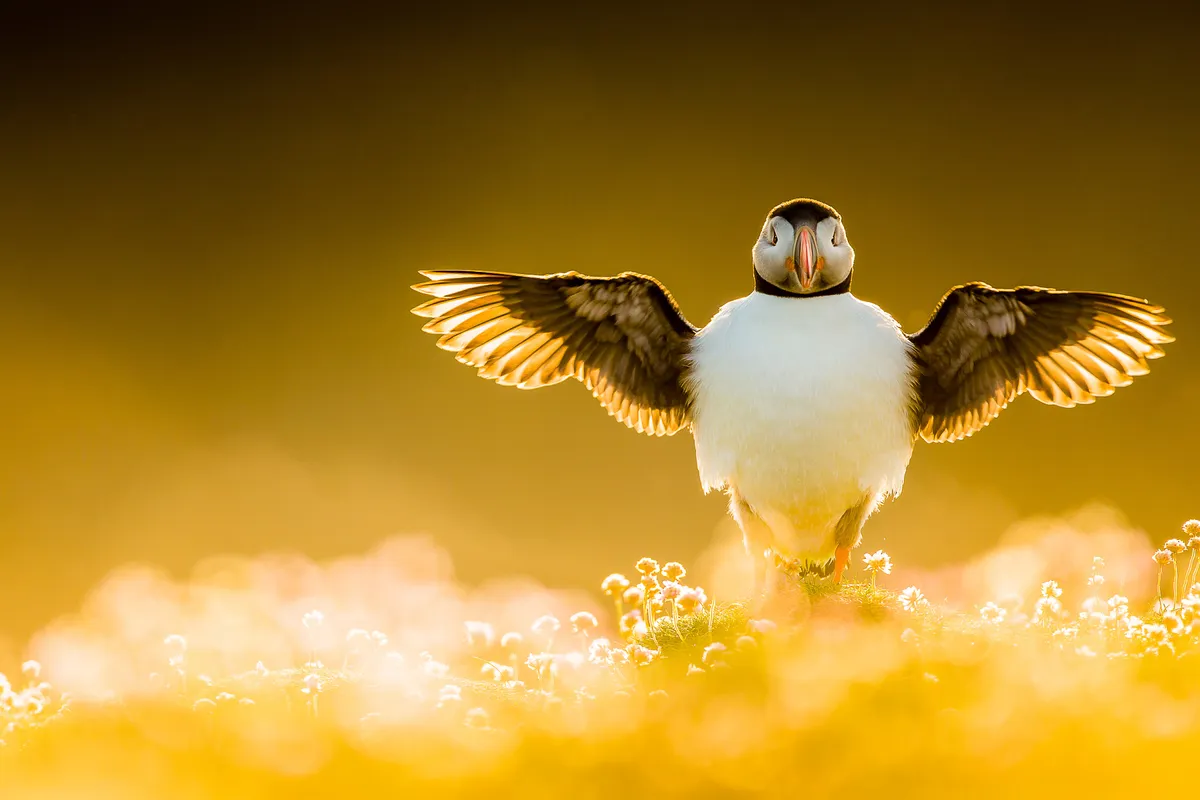
"Back-lighting is strongly represented throughout this portfolio. Combining the technique with the beautiful golden hues of sunset can transform an image, and birds in particular look fantastic using this approach. The light shining through their feathers creates an almost translucent effect."
Canon EOS-1D X with Canon EF 500mm f/4L lens. Focal length 500mm, 1/1,250 second, f/4, ISO 400.
STANDING IN THE RAIN: Atlantic puffin, by Kevin Morgans (UK).
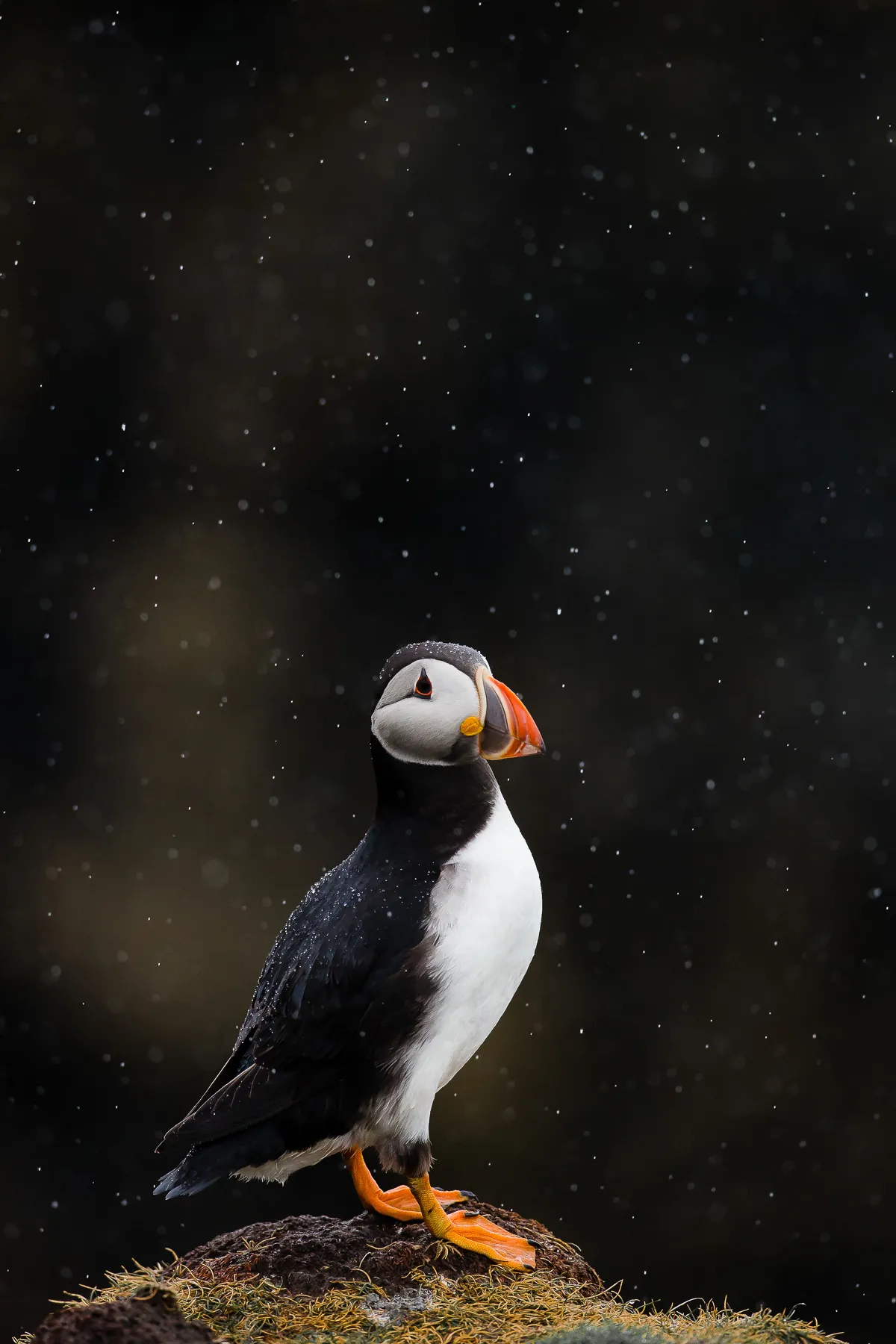
"Photographing in rainfall adds an extra element to your imagery. How you represent the rain is open to your creativity – for example, you may want to shoot using a slow shutter speed that renders the droplets as streaks. For this image, I chose the alternative – a fast shutter speed, at 1/3,200 second, to freeze the droplets and render an almost starry-night feel to the rain."
Canon EOS-1D X with Canon EF 500mm f/4L lens. Focal length 500mm, 1/3,200 second, f/5.6, ISO 2,500.
LOST IN THOUGHT: Atlantic puffin, by Kevin Morgans (UK).
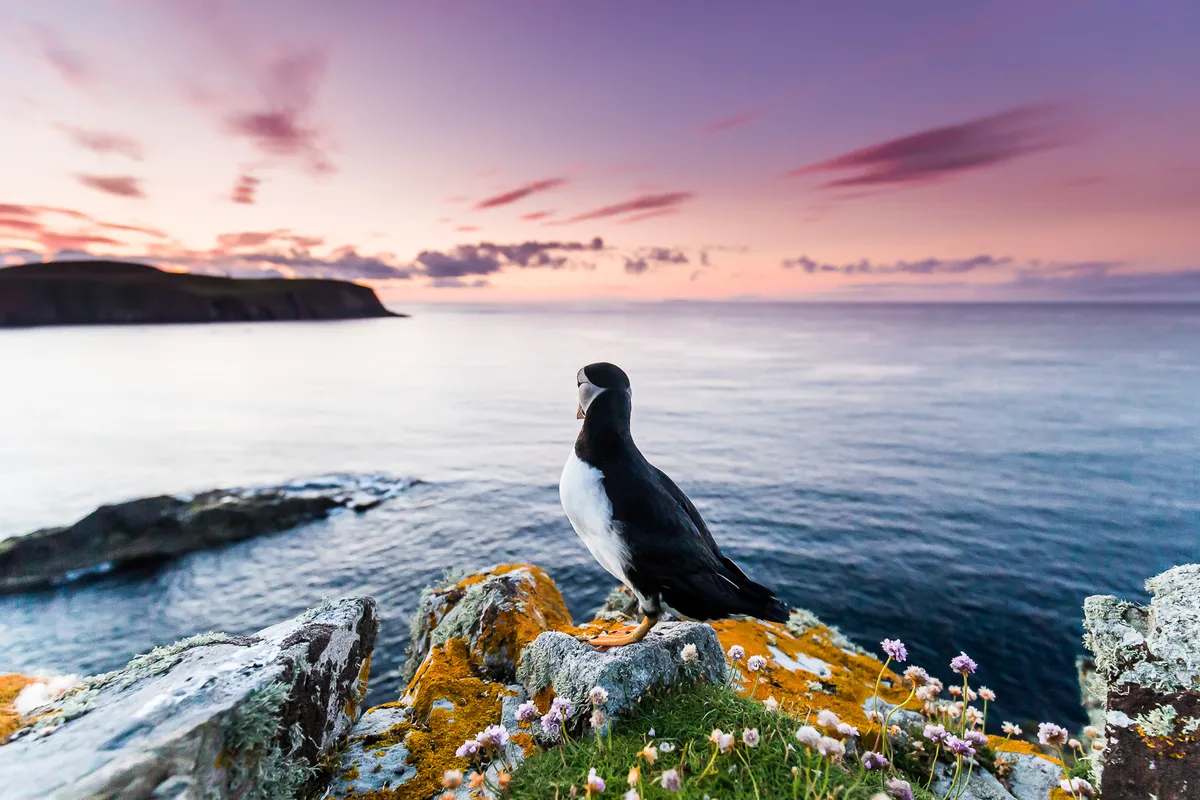
"When photographing an animal, eye contact is a critical component, allowing your viewer to connect with the image. This photo breaks many of the traditional rules. The setting sun, the uneasy pose of the puffin and the central composition throw up many questions and thoughts. Where is the puffin looking? What is it thinking? What lies beyond the horizon?"
Canon EOS-1D X with Canon EF 16–35mm f/4 IS lens. Focal length 16mm, 1/100 second, f/4, ISO 1,250.
GOLDEN CALM: Atlantic puffin, by Kevin Morgans (UK).
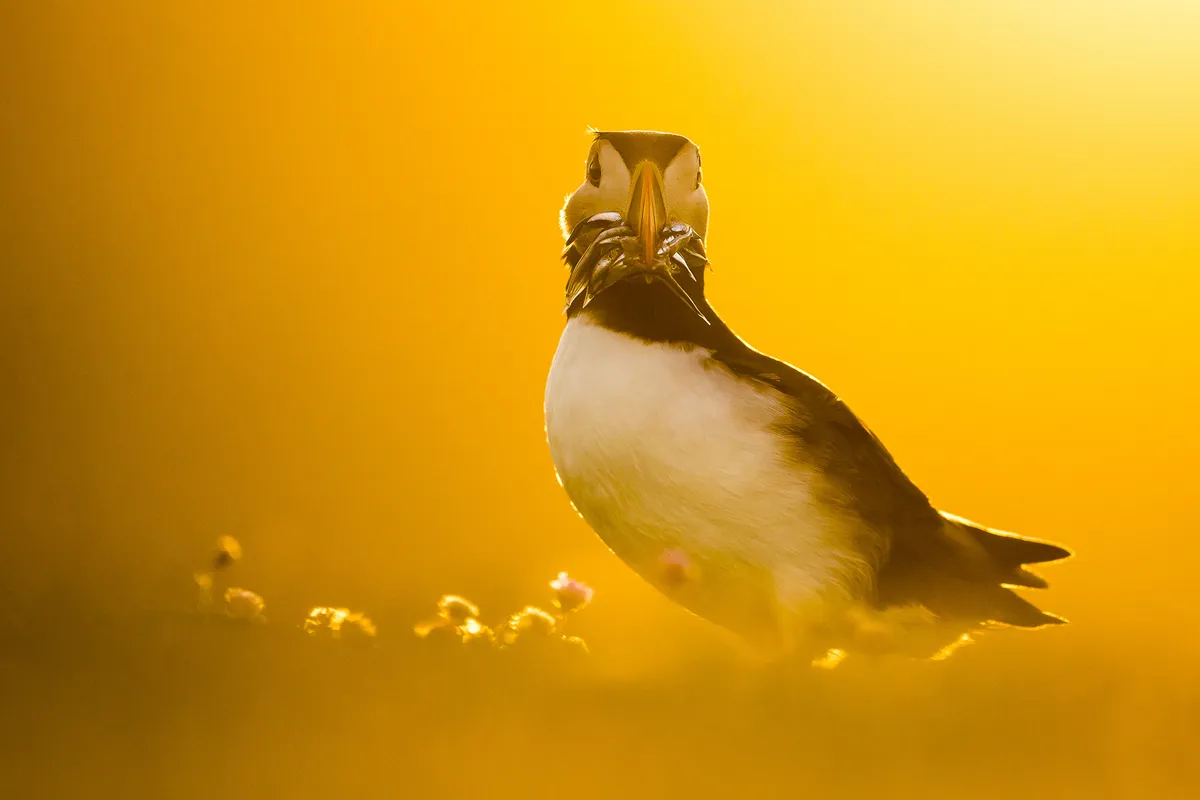
"Photography isn’t always about what you include in an image; it’s also about what you exclude. Throughout my photography, I like to seek out and isolate moments of calm in what is a hectic, bustling seabird colony. By choosing to exclude any distracting elements, the viewer’s gaze is drawn to the vital part of the image. Additionally, the stunning golden light helps to enhance the beauty of the moment."
Canon EOS-1D X with Canon EF 500mm f/4L lens. Focal length 500mm, 1/8,000 second, f/4, ISO 1,600.
CIRCLES OF GOLD: Atlantic puffin, by Kevin Morgans (UK).
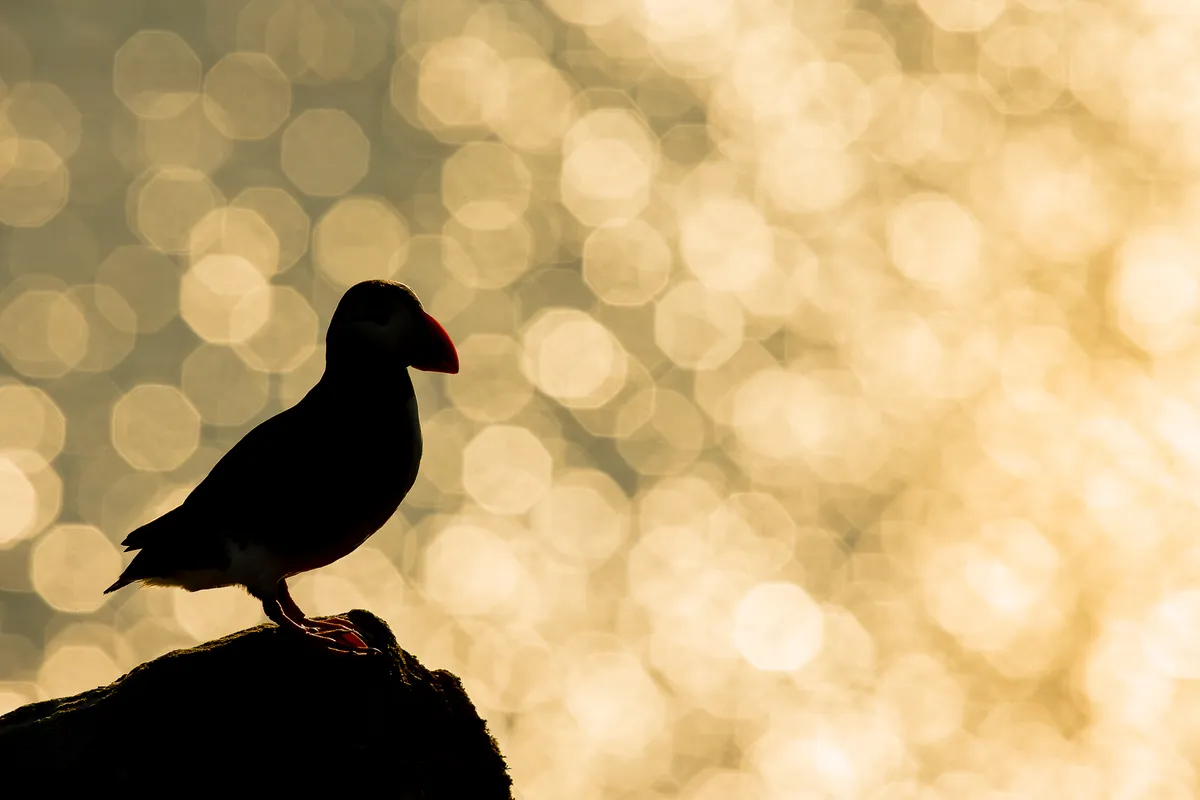
"Whilst photographing puffins I'm constantly searching for new and innovative ways to capture the lives of these fantastic seabirds. Late one evening, shafts of light from the setting sun were hitting the water below. Exposing for the brightest part of the image and dialling in an aperture of f10 allowed me to render the background as balls of light and capture this unique silhouette of a puffin. However well a species has been documented, there is always a new shot to be had."
Canon EOS-1D X with Canon EF 500mm f/4L lens. Focal length 500mm, 1/2,500 second, f/10, ISO 400.
THE UNKNOWN: Atlantic puffin, by Kevin Morgans (UK).
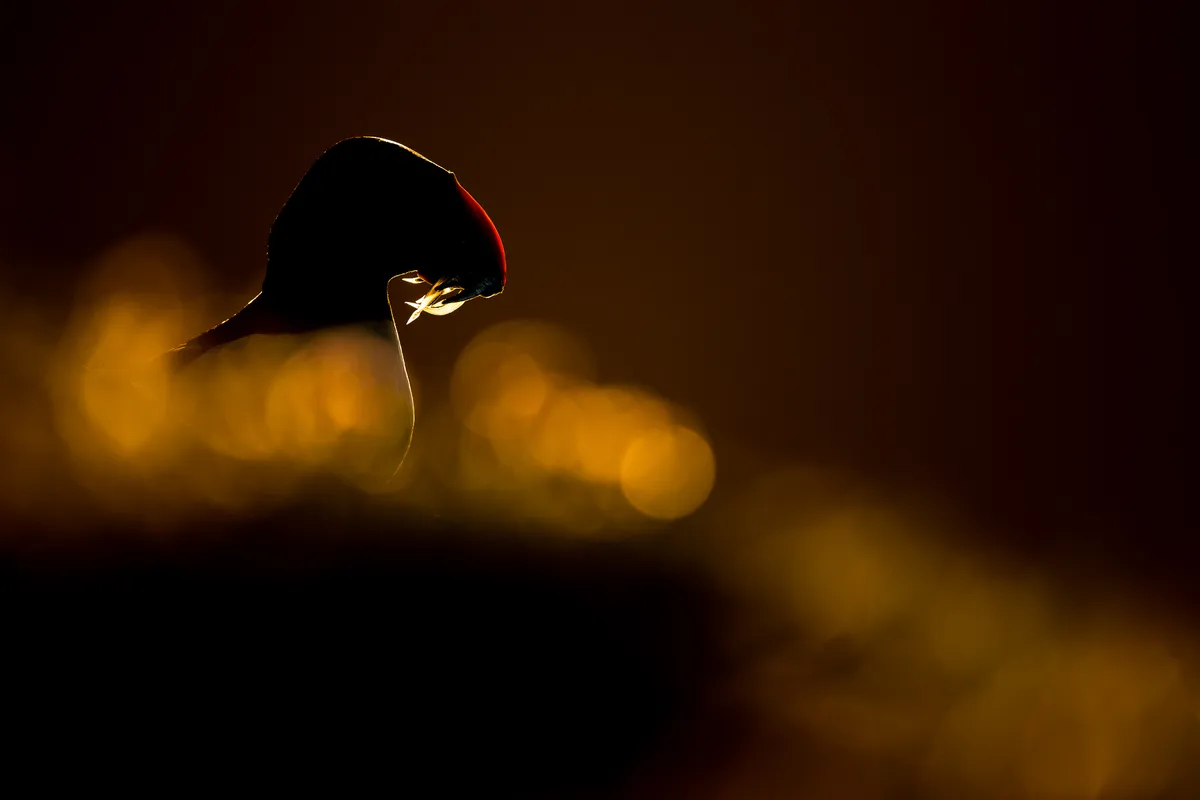
"Backlighting is a tricky style to master but, if done correctly, can often create a dramatic feel to your photography, images packed full of atmosphere and suspense. I find myself drawn to this extreme backlighting due to its emphasis on shapes rather than detail. When shooting using this approach you want distinctive shapes that make your subject easily recognizable to the viewer, such as the outline of a puffins beak."
Canon EOS-1D X with Canon EF 500mm f/4L lens. Focal length 500mm, 1/1,250 second, f/4, ISO 100.
Category: Conservation Award
Gold Award winner. BEAUTIFUL SCAVENGERS: Greater adjutants, by Carla Rhodes (USA)
"Towering at 1.5m tall and with a wingspan of 2.5m, greater adjutants are the most endangered species of stork on the planet. Today, there are fewer than 1,200 of these beautiful scavengers left in existence, with the global stronghold of 950 residing in Assam, India.
This photographic documentary charts the work of biologist Purnima Devi Barman, who has dedicated her life to leading an inspiring and innovative conservation movement to save greater adjutants. Founder of the so-called Hargila Army, a local all-female grassroots volunteer conservation effort, Purnima and her team protect nesting trees, save injured birds and educate the Assamese community about the importance of these rare scavengers."
BEAUTIFUL SCAVENGER, by Carla Rhodes (USA)
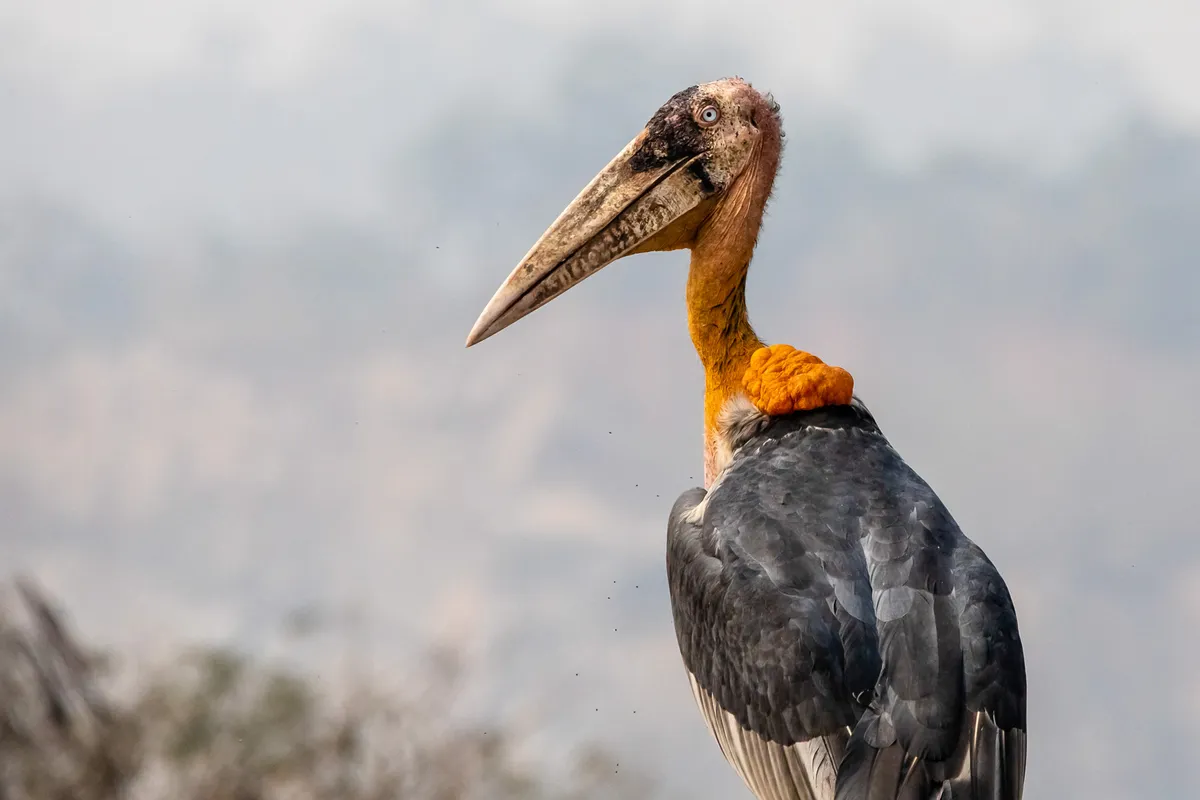
"An endangered greater adjutant is pictured in the Boragaon landfill located in Guwahati, Assam India. The landfill has the largest year-round concentration of greater adjutant storks in the world. Out of the world’s 19 species of storks, the greater adjutant is the rarest and most endangered.
The Zoological Society of London classified the bird as an EDGE species in 2014, meaning it is close to extinction. In 2016, the International Union for Conservation of Nature estimated only 800-1200 individuals were left, firmly cementing their status as endangered with a decreasing population."
INFORMATION IS KEY, by Carla Rhodes (USA)
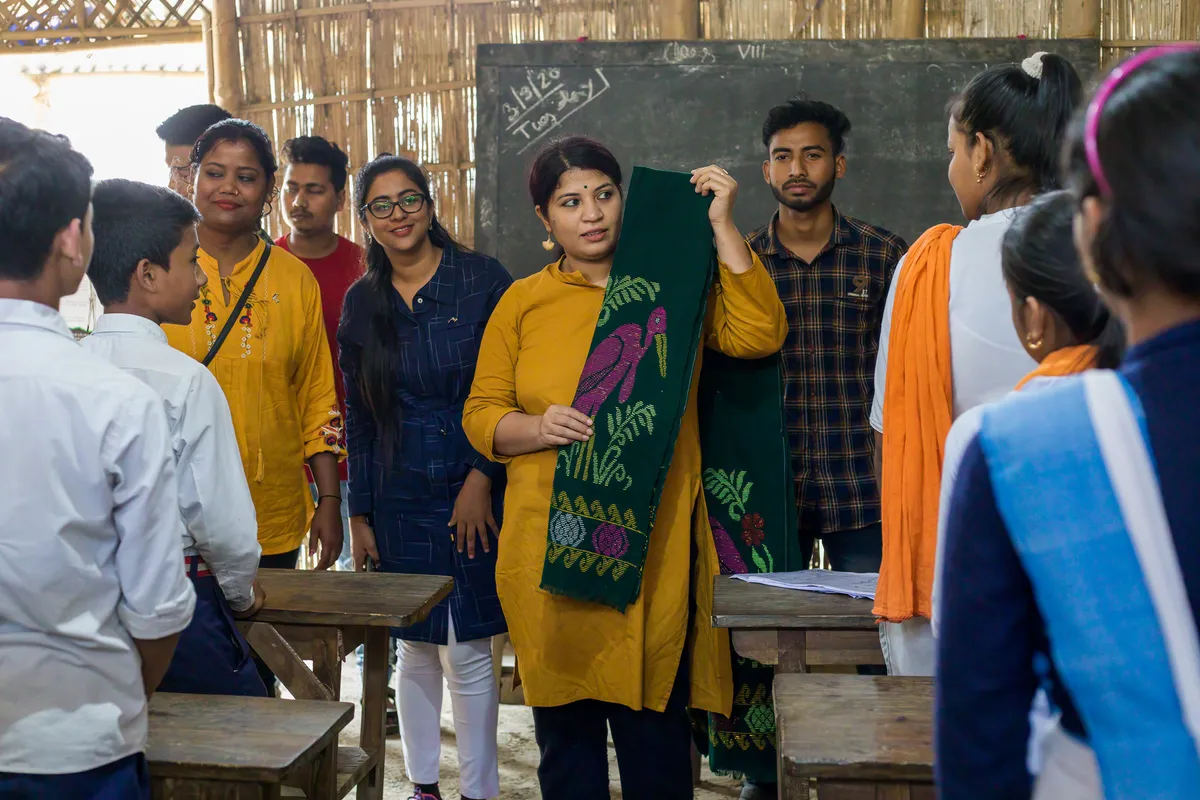
"Purnima Devi Barman presenting an educational programme on greater adjutants at a school in Kamrup district.
Here, Barman is showing off textiles woven by Hargila Army members. These feature a greater adjutant design motif, one that has been incorporated into traditional materials and products, including mekhela chador and gamosa. She regards education as being key to the long-term success of the project: if students are taught at a young age to respect Greater Adjutants, they will become the species’ advocates and protectors in the future."
Canon EOS 5D Mark IV with Canon EF 50mm f/1.8 lens. Focal length 50mm, 1/160 second, f/4, ISO 8,000.
SENTINELS: Greater adjutants atop a monstrous mound of garbage, by Carla Rhodes (USA)
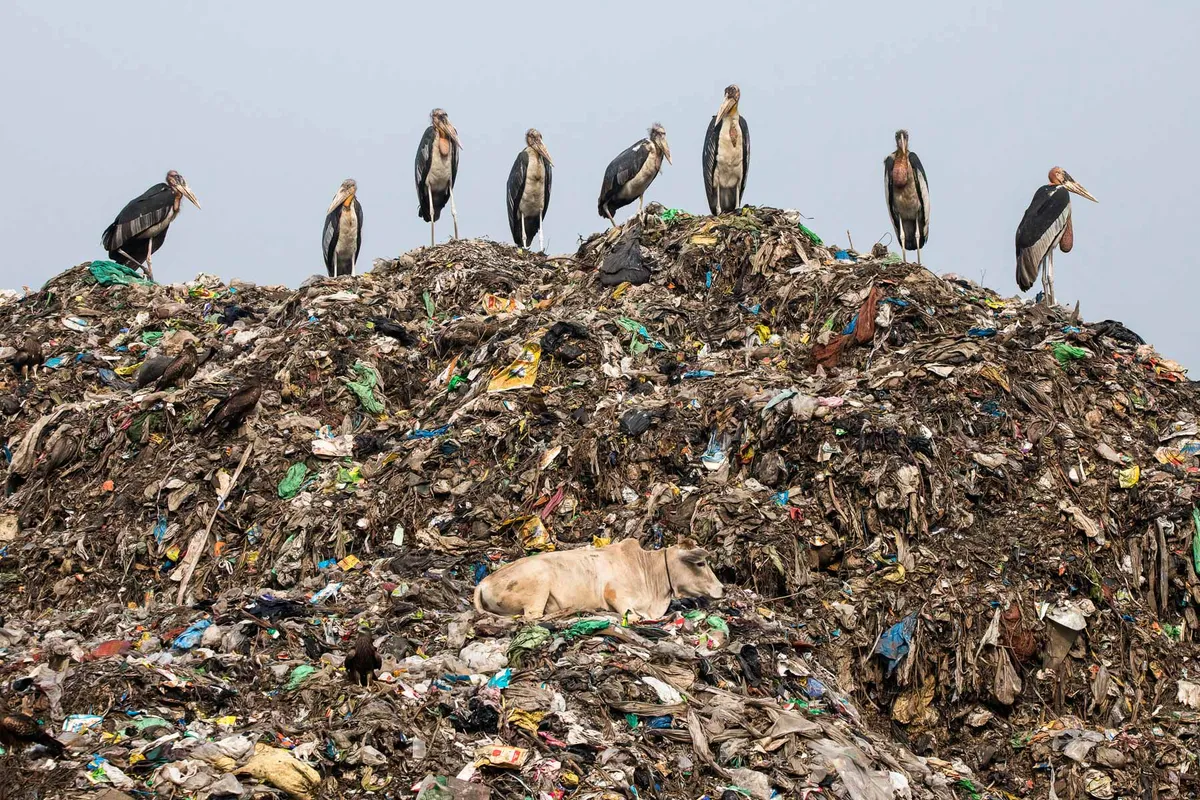
"The location for this image and the Conservation Documentary Award story is the Boragaon Landfill, near the city of Guwahati in India. Encroaching on the Deepor Beel Wetland, the landfill continues to destroy priceless freshwater habitat and impacts wildlife in more insidious ways through pollution and toxic seepage."
Canon EOS 5D Mark IV with Sigma 150–600mm F5–6.3 DG OS HSM Contemporary lens. Focal length 160mm, 1/2,000 second, f/11, ISO 2,000.
GARBAGE ON AN INDUSTRIAL SCALE, by Carla Rhodes (USA)
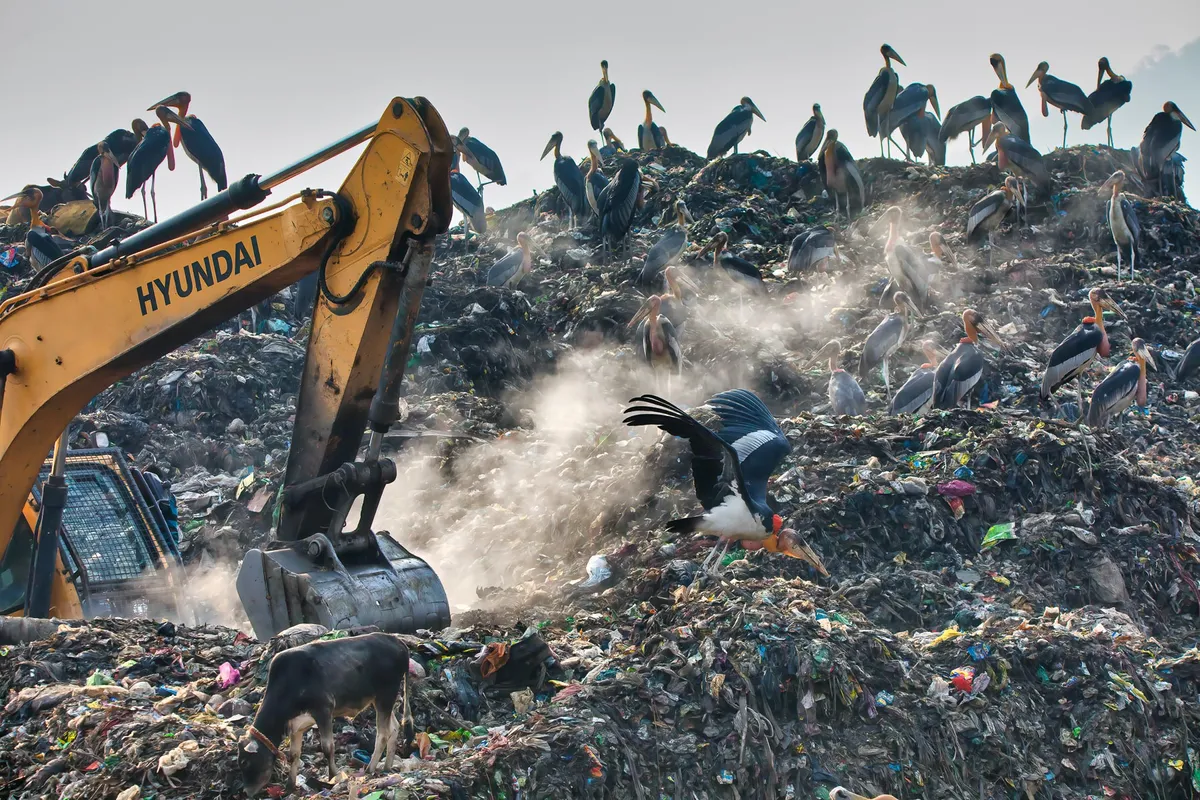
"The Boragaon Landfill is a growing concern, both literally and figuratively. Deepor Beel’s status as a Ramsar site has done little in practical terms to protect it, and the wetland’s footprint has shrunk from an original 4,000ha to an alarming 500ha today. The landfill grows in grim stature on a daily basis, and with their natural habitat destroyed, greater adjutants are forced to rely increasingly on scavenging at the garbage dump for their existence."
Canon EOS 5D Mark IV with Sigma 150–600mm F5–6.3 DG OS HSM Contemporary lens. Focal length 150mm, 1/1,600 second, f/8, ISO 1,250.
VISUAL AIDS, by Carla Rhodes (USA)
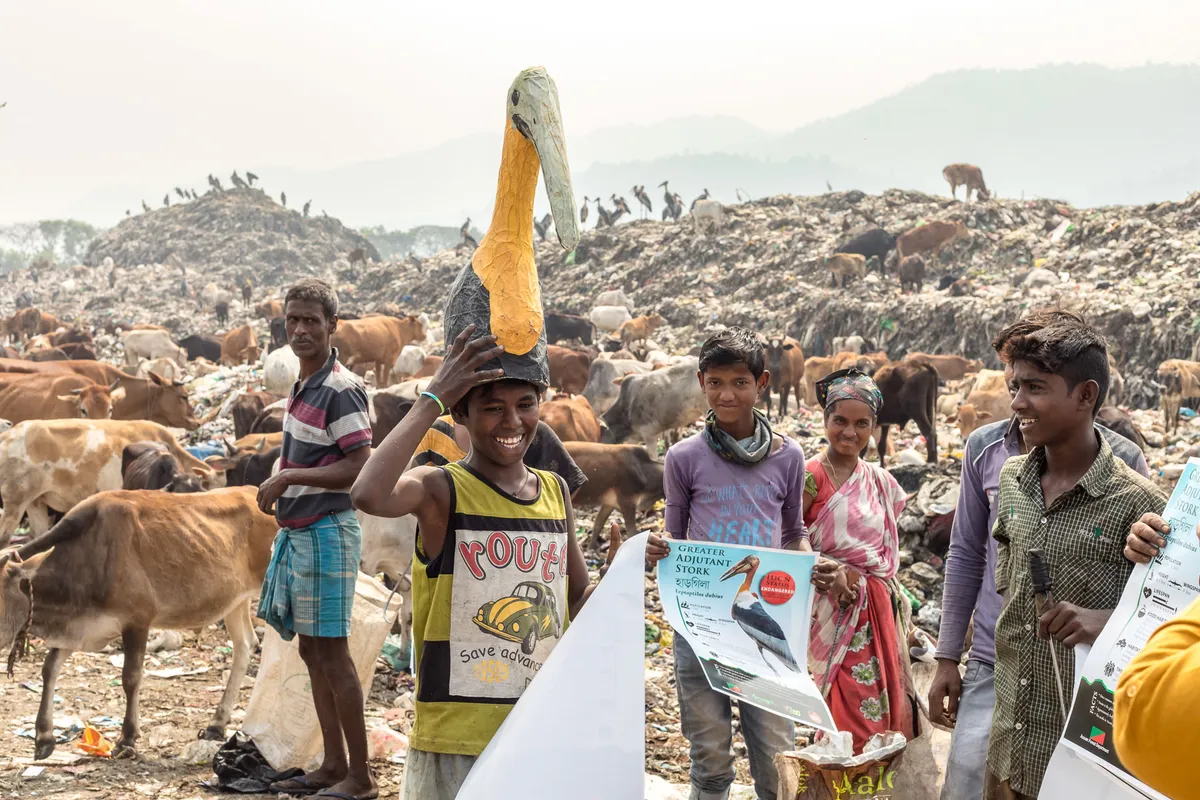
"Migrant rag-pickers sorting garbage at the Boragaon Landfill. Cultivating personal relationships with the local community is a key component of Barman’s successful conservation model. Here, a young boy who lives and works on the landfill as a migrant rag-picker is pictured enjoying the moment he tries on a papier-mache stork headdress. Barman and her Hargila Army hope to bring a bit of fun and joy to the community, thereby instilling a sense of empathy and concern for their fellow landfill residents, the storks."
Canon EOS 5D Mark IV with Canon EF 50mmf/1.8 lens. Focal length 50mm, 1/500 second, f/9, ISO 400.
WORKING WITH THE LOCAL COMMUNITY, by Carla Rhodes (USA)

"Informing and educating local people is a vital part of the work of the Hargila Army. Hargila Army founder and valiant activist Purnima Devi Barman (left) is seen here distributing information posters about Great Adjutants. Her enthusiasm for these beleaguered birds is infectious – one reason why her ‘army’ is going from strength to strength. Since Barman began her efforts 10 years ago, the local population of greater adjutants has grown from 400 to an estimated 950 birds."
Canon EOS 5D Mark IV with Canon EF 50mm f/1.8 lens. Focal length 50mm,1/320 second, f/8, ISO 4,000.
Category: 14-17 years
Gold Award winner (and overall Young Bird Photographer of the Year). MORNING LEK: Black grouse, by Levi Fitze (Switzerland).

"I spent a lot of time with black grouse last spring. After photographing them several times with my telephoto lens, I decided to try something new. In the afternoon I made my way once again to the lekking area of these impressive birds. After an hour of hiking, I had reached my destination. This time, next to my telephoto, I had stowed a wide-angle lens in my backpack.
That evening I was the only person in this area. From far away I could hear the cows on the distant Alps, but otherwise it was the indescribable silence of the mountains that I remember. After a warm dinner cooked on the gas stove and a cold night in my sleeping bag, my alarm clock rang at four in the morning. I crept to my tripod, which I had already mounted the day before, and brought the camera into position. Then I hid under a camouflage net and waited and waited. It was freezing cold and I made sure that the connection from my camera to the iPhone would not break.
After around 30 minutes I was suddenly surrounded by shadows and the beautiful sound of lekking black grouse broke the silence. When I saw a male right in front of my camera, I realised that my plan might actually work. It got lighter and lighter. I had already taken the first pictures. Then the sun rose, exactly where I had hoped it would be. Again, a black grouse appeared, and now everything was perfect. I hit the release button and hoped I would get this shot..."
Sony a7R IV and Sony 16–35mm f/2.8 lens. Focal length 16mm, 1/100 second, f/22, ISO 320.
Silver Award winner. THE NIGHTJAR: European nightjar, by Daniel Martinez (Spain).
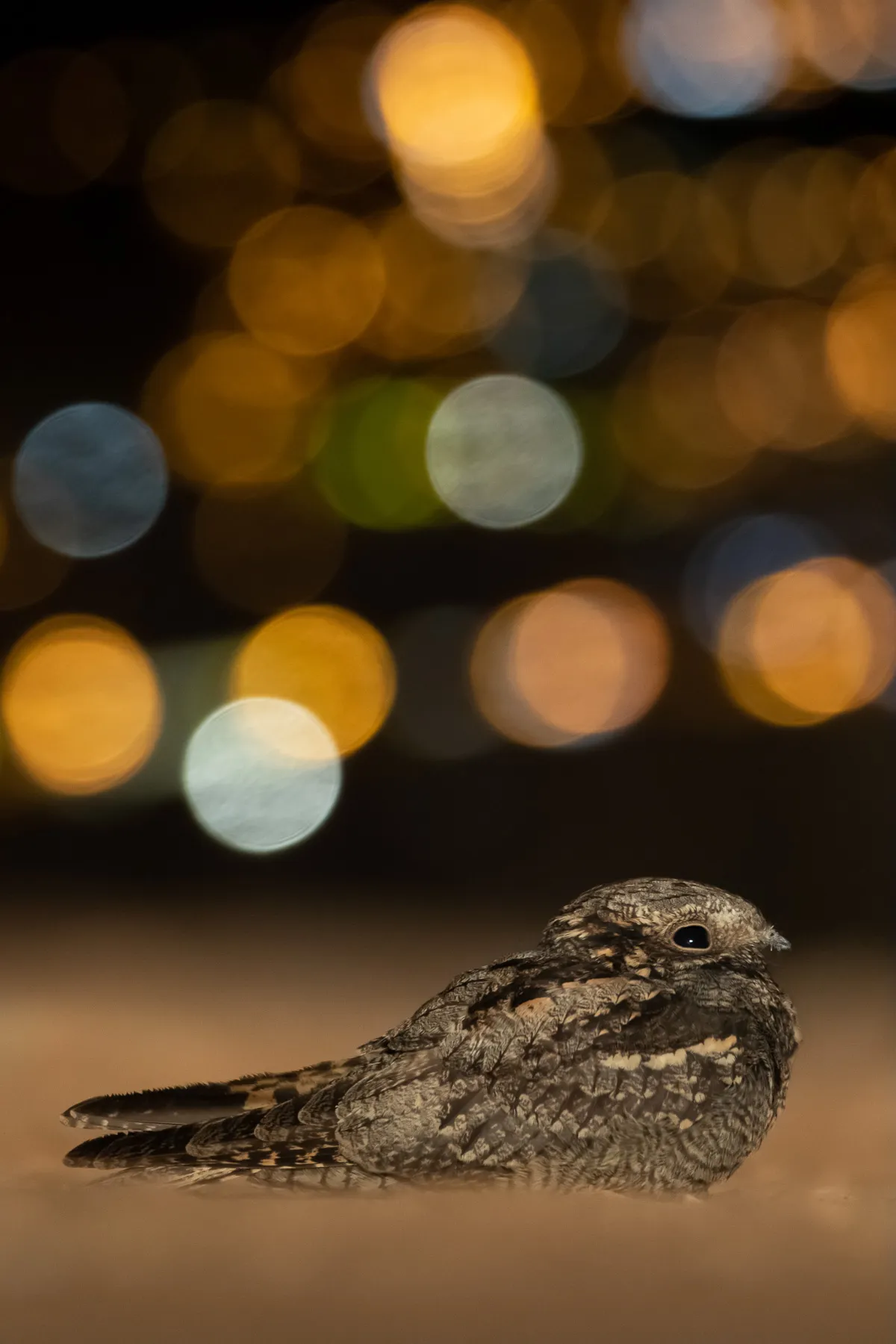
"On summer nights, European nightjars use roads as hunting grounds since flying insects are attracted to them, due to the heat accumulated in the earth, stones and asphalt. I decided to try something different, combining the photo of the bird at ground level with the lights of my town in the background, to give the photo that night-time touch."
Canon EOS 7D Mark II with Tamron 150–600mm f/5–6.3 lens. Focal length 400mm, 1/8 second, f/5.6, ISO 3,200.
Category: 9-13 years
Gold Award winner. IN THE WOODLAND: Eurasian nuthatch, by Andrés L. Domínguez Blanco (Spain).
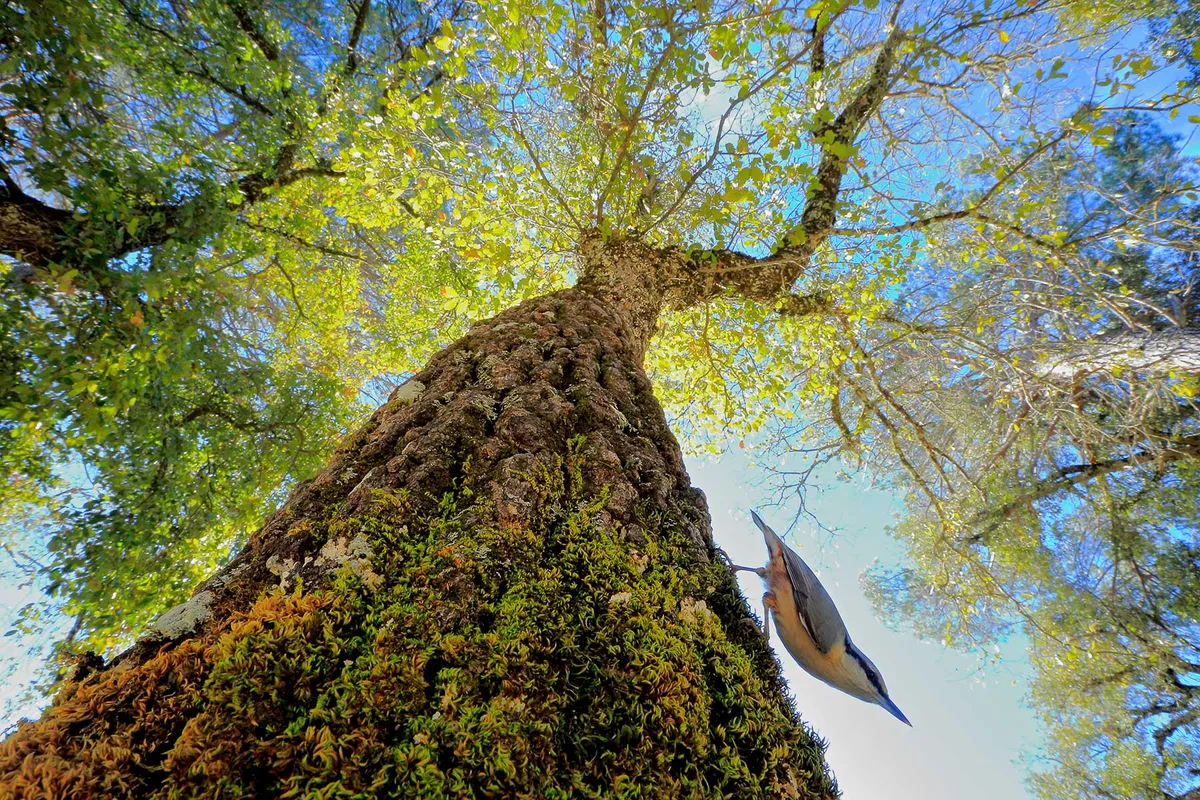
"This Eurasian nuthatch regularly used the trunk of a Portuguese oak as a route to go down to drink. This picture was taken with a wide-angle lens and remote control from a hide. It gave me this unusual perspective of the bird through the use of a creative approach to bird photography."
Canon EOS 5D Mark III with Canon 16–35mm f/2.8 II lens. Focal length 16mm, 1/25 second, f/22, ISO 1,250.
Silver Award winner. PEREGRINE SPOILT FOR CHOICE: Peregrine falcon, by Thomas Easterbrook (UK).
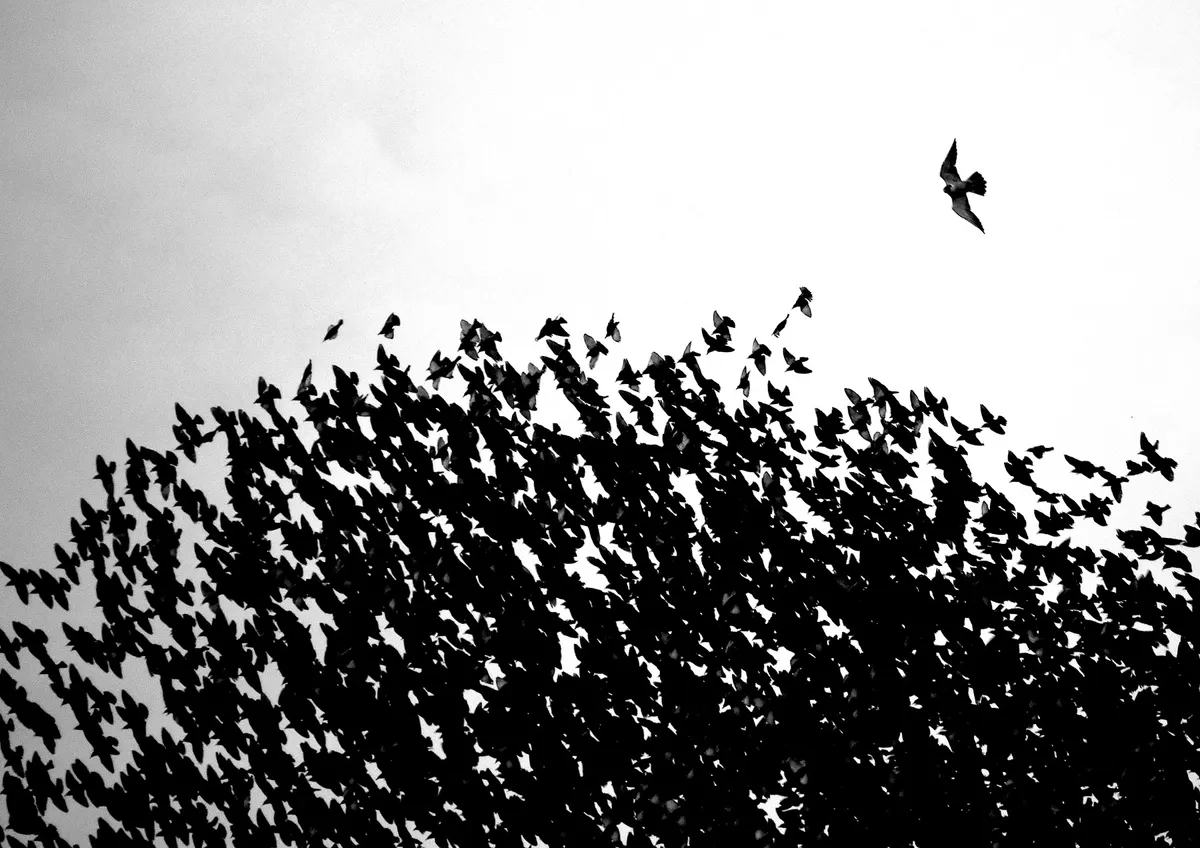
"I took this photo while on holiday in Suffolk. We had gone out hoping to see a common starling murmuration. Shortly after the murmuration began, a peregrine falcon appeared and attacked the murmuration, forcing it into different shapes. It was a dramatic sight that lasted only a few minutes, and I was pleased to capture this image of the Peregrine about to attack."
Nikon D7500 with NIKKOR 18–300mm f/3.5–6.3 lens. Focal length 300mm, 1/640 second, f/6.3, ISO 800.
Category: 8 and under
Gold Award winner. I SEE YOU: Short-eared owl, by Deeksha Sambath (India).

"Short-eared owls are migrant visitors to grasslands around my home town of Chennai in India. I spent a lot of time observing them from a car and this image was taken from the window of my dad’s car. I love the eye contact of the bird and the composition of this picture."
Canon EOS 7D Mark II with Canon 400mm f/5.6 lens. Focal length 400mm, 1/640 second, f/6.3, ISO 400.
Silver Award winner. SUDDEN TURN OF A TERN, by Filip Niziolek (Poland).
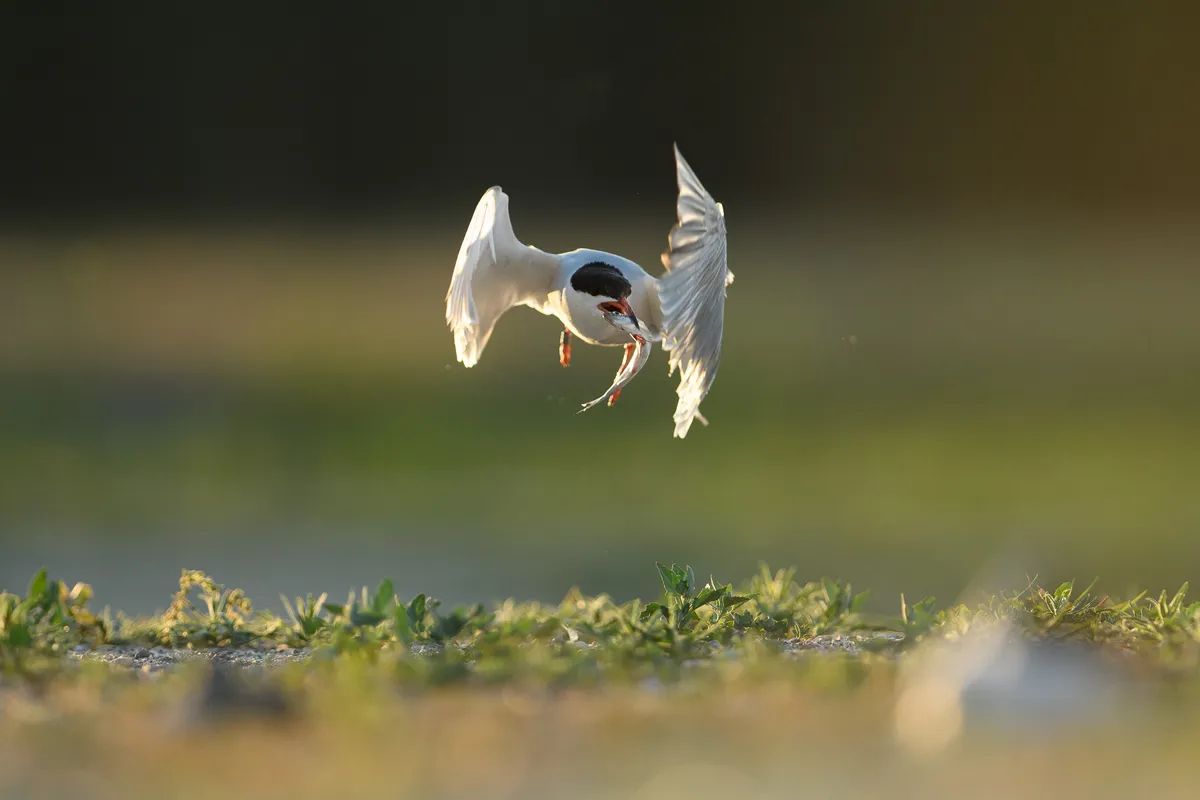
"A tern flying a fish back to its chick."
Nikon D500 NIKKOR 300mm f/2.8 lens. Focal length 300mm, 1/3200 second, f/2.8, ISO 800.